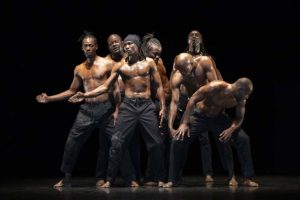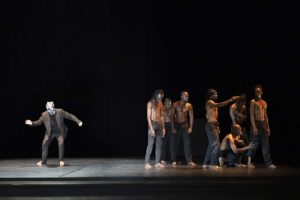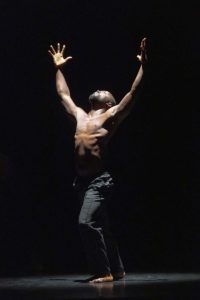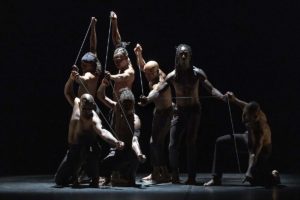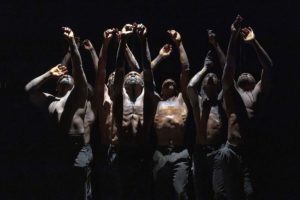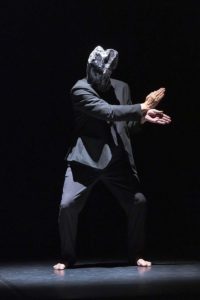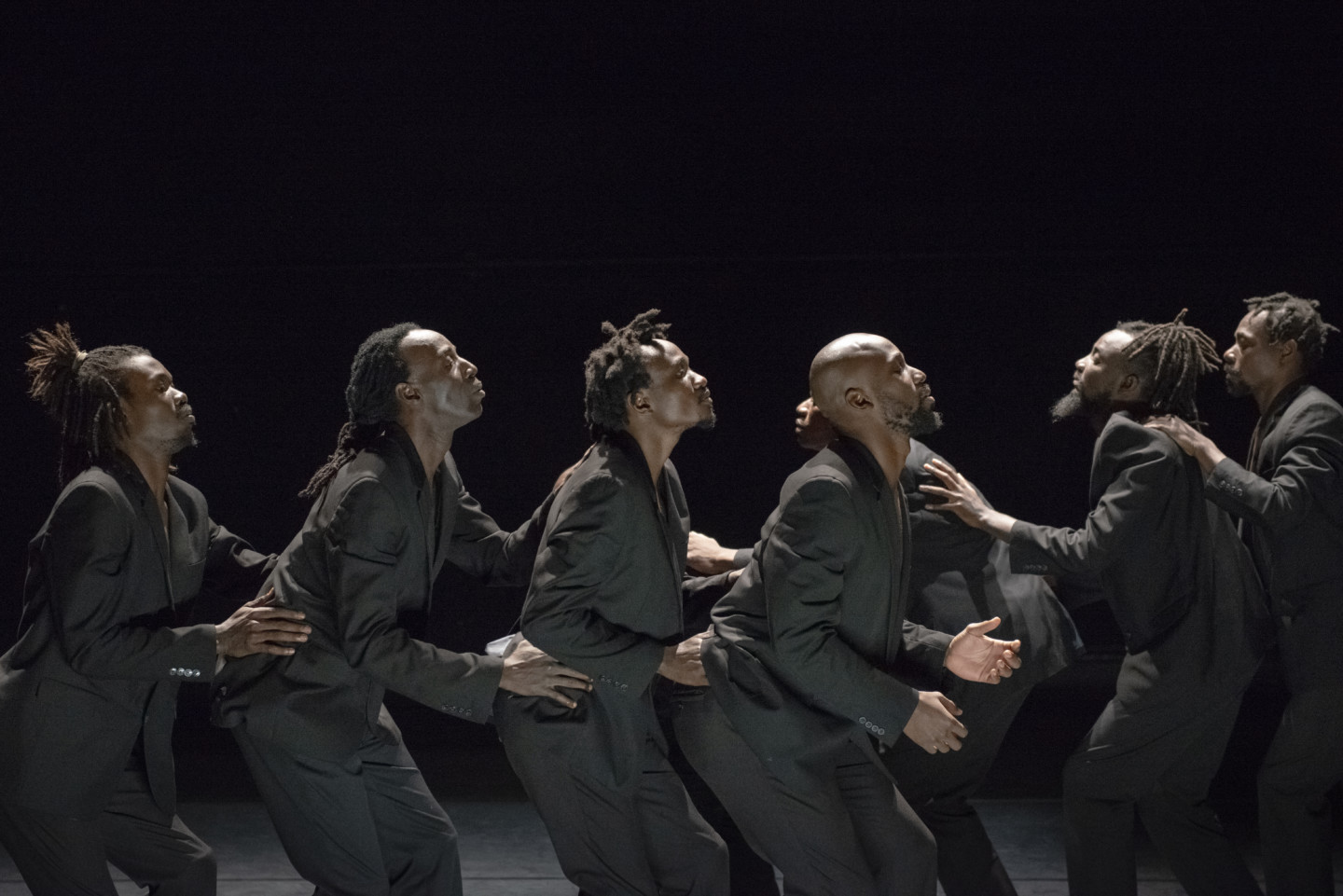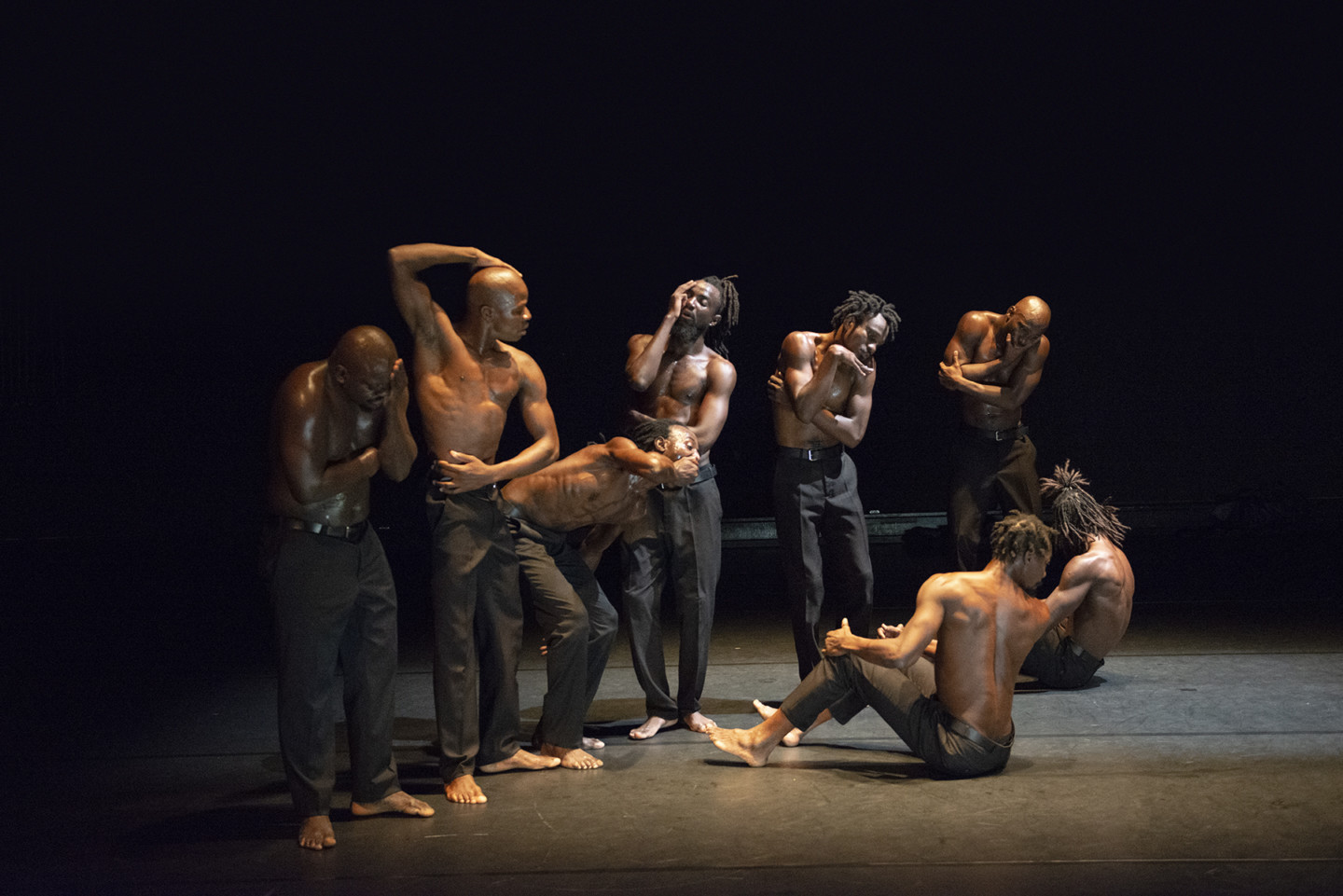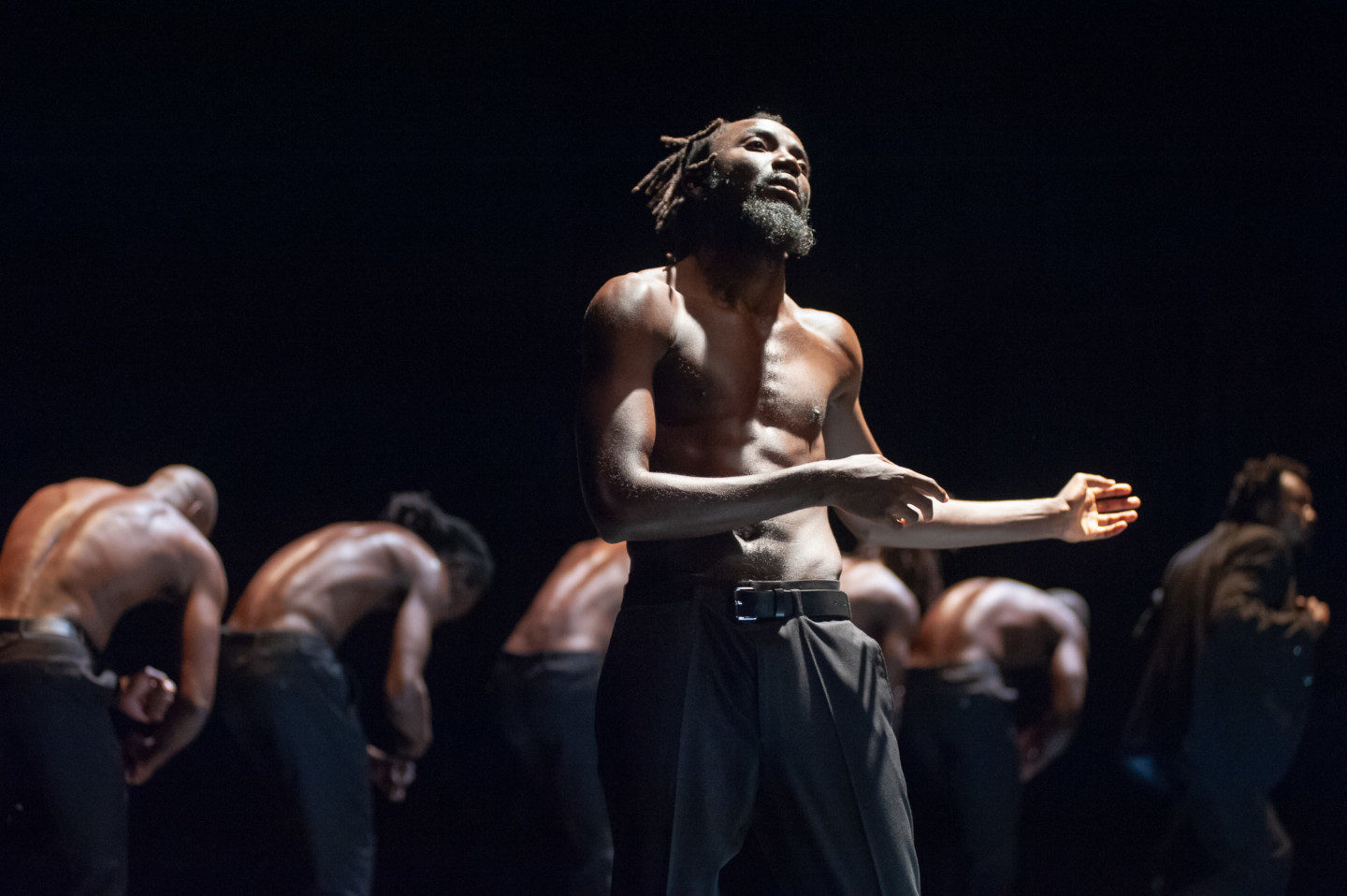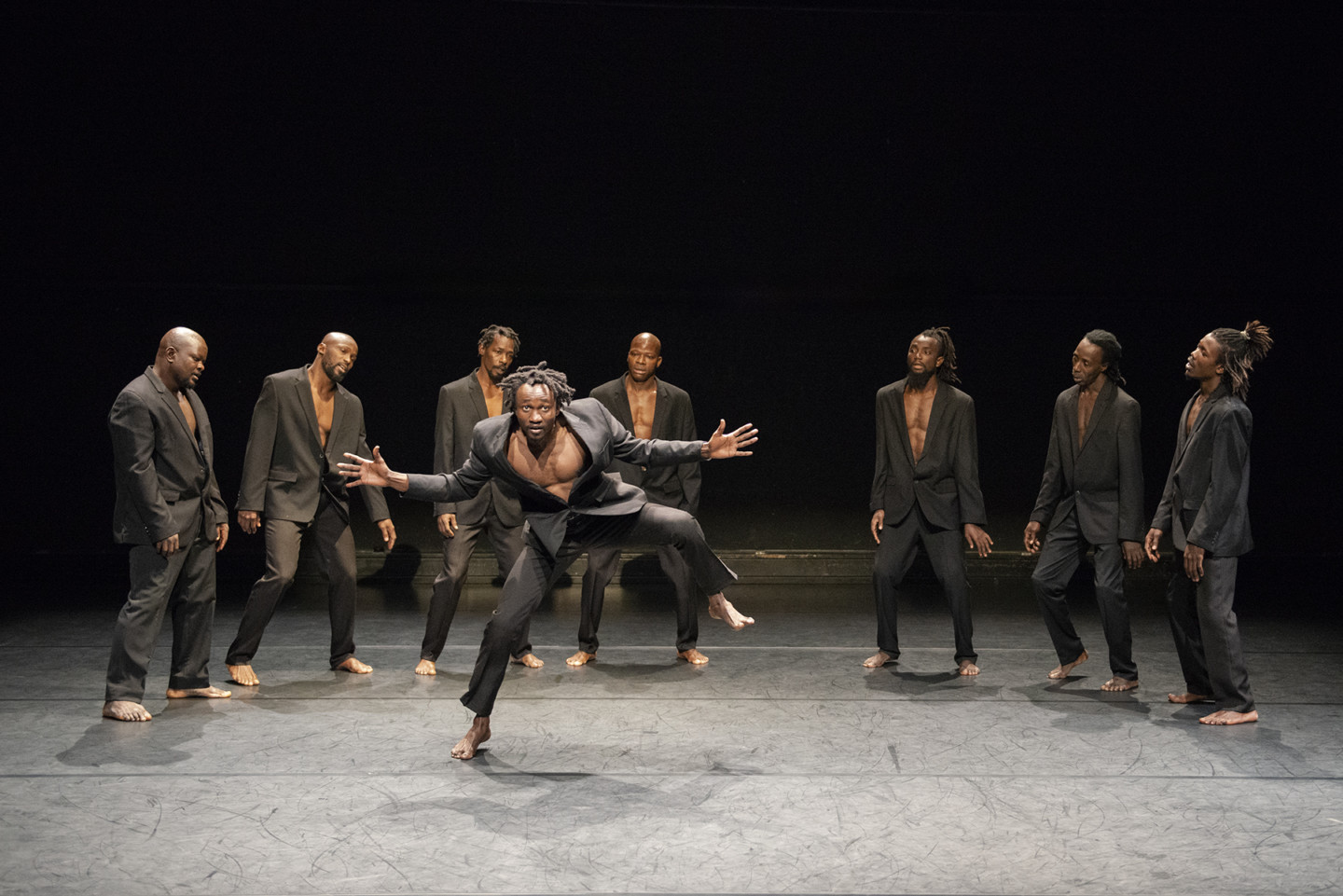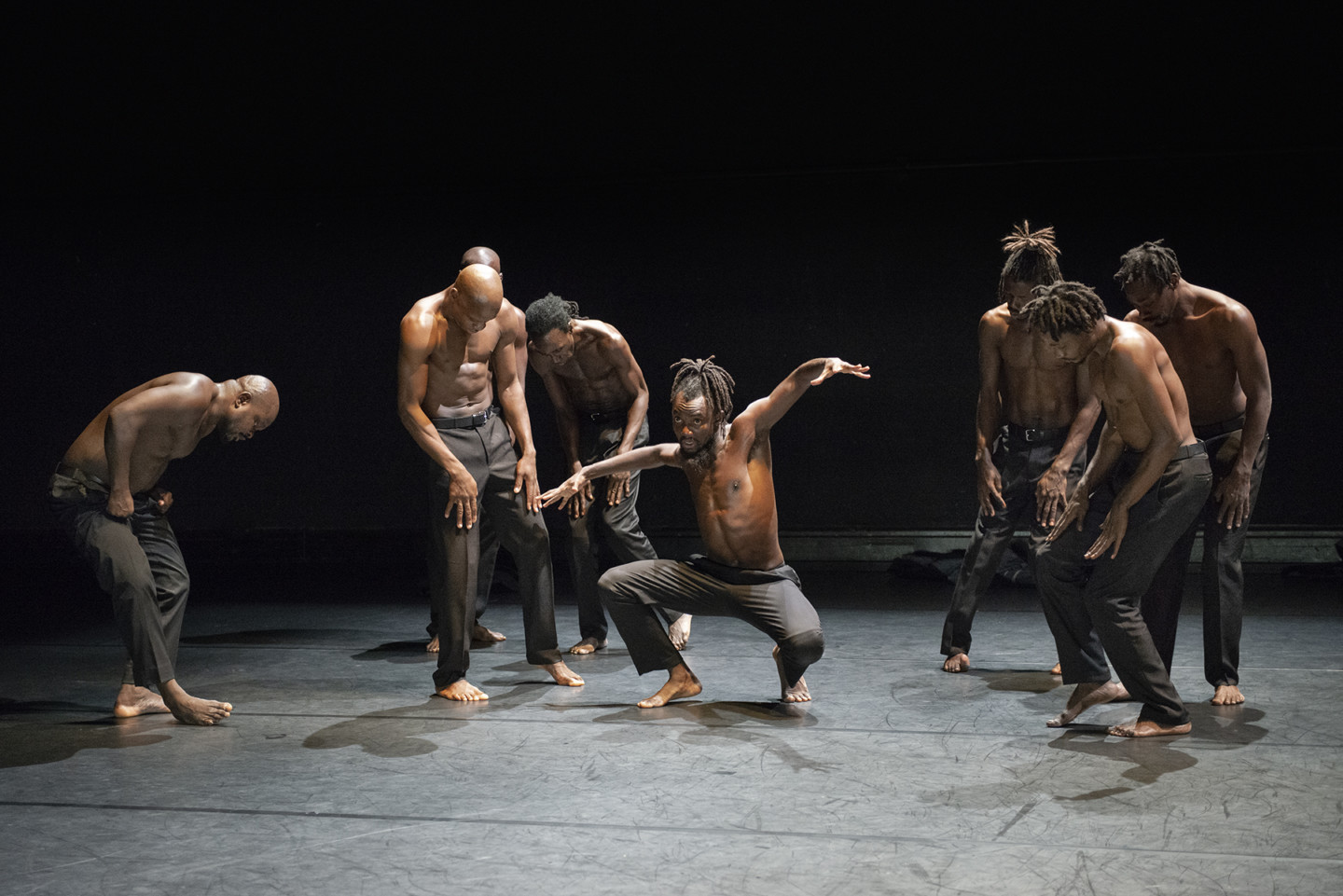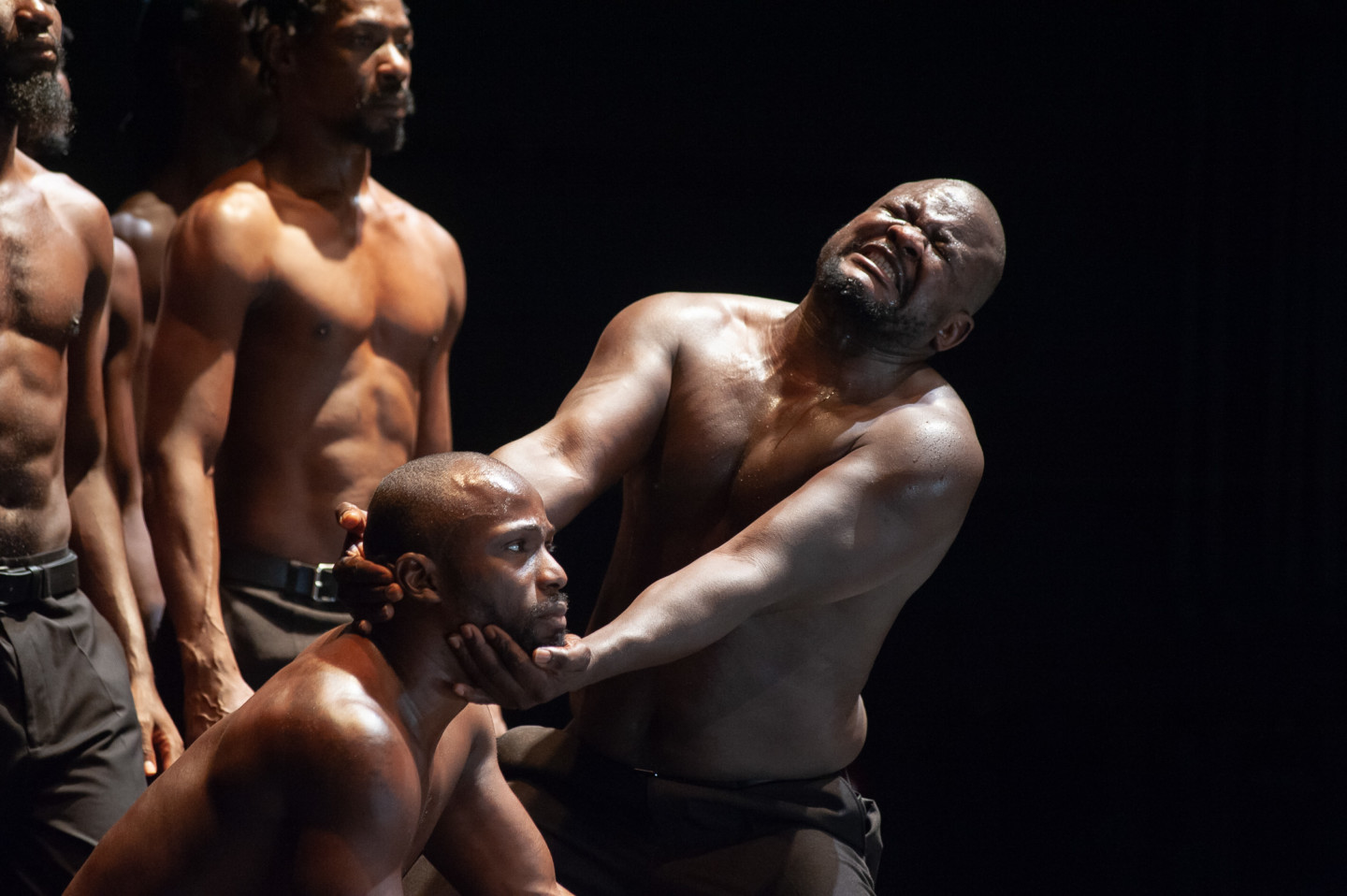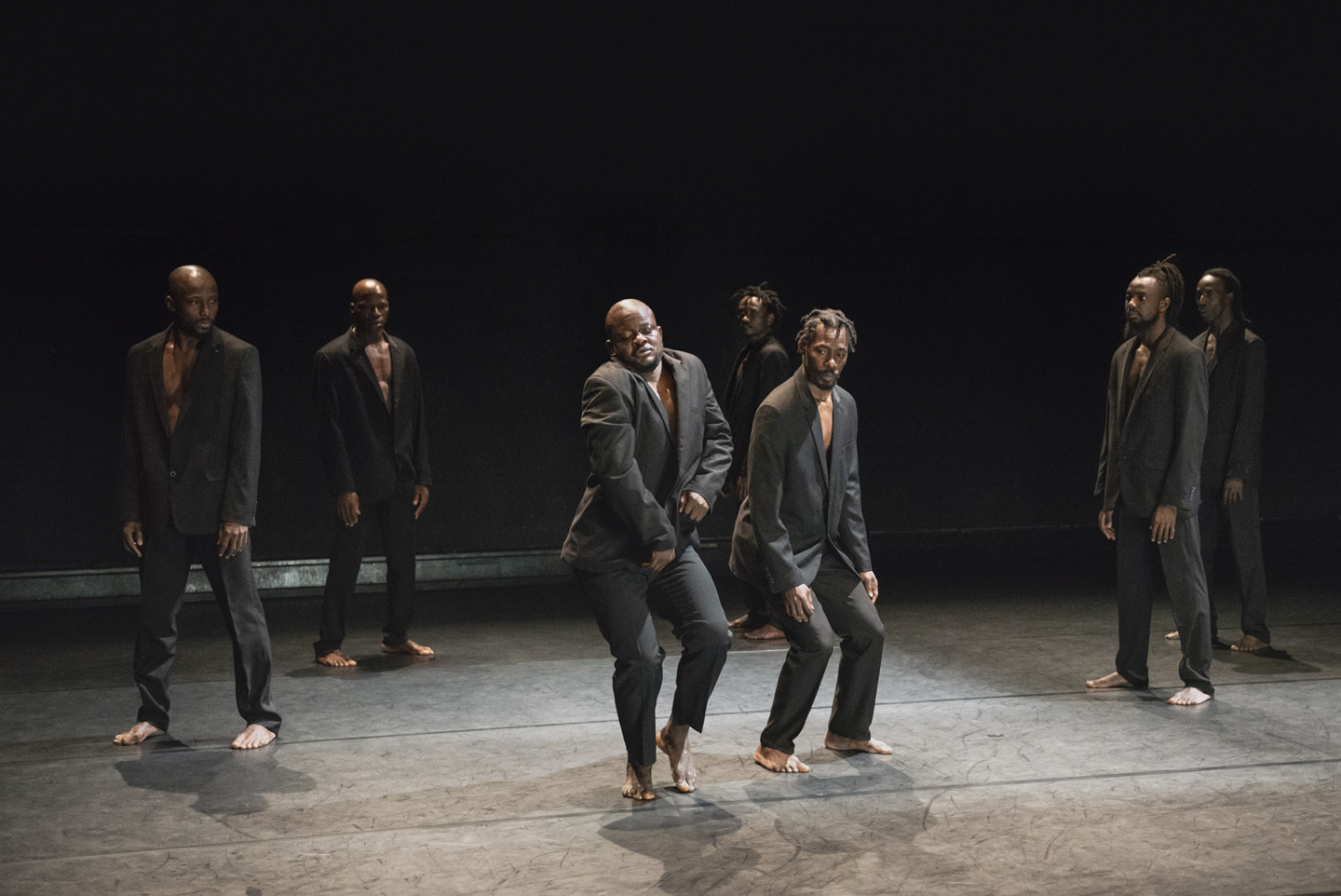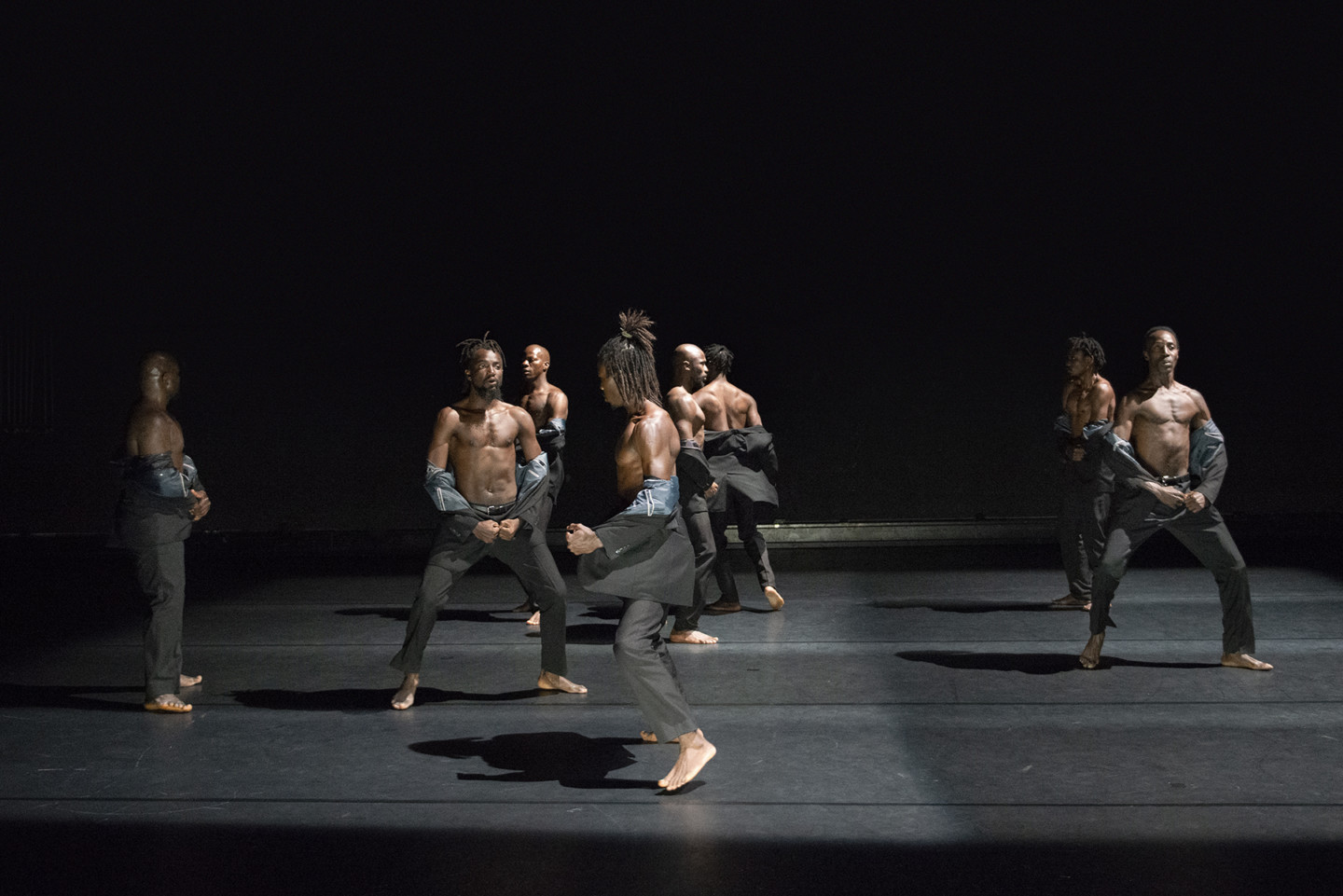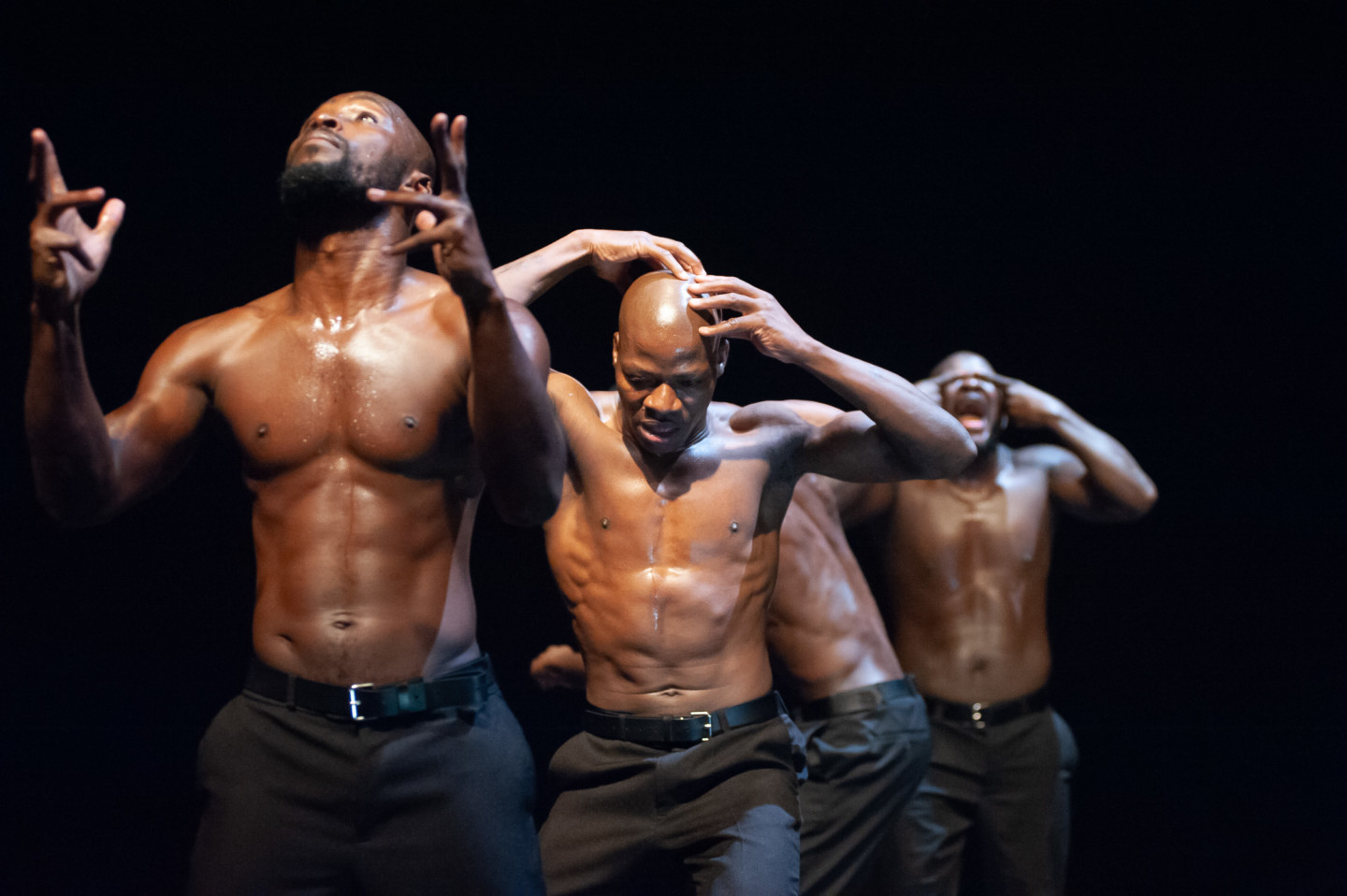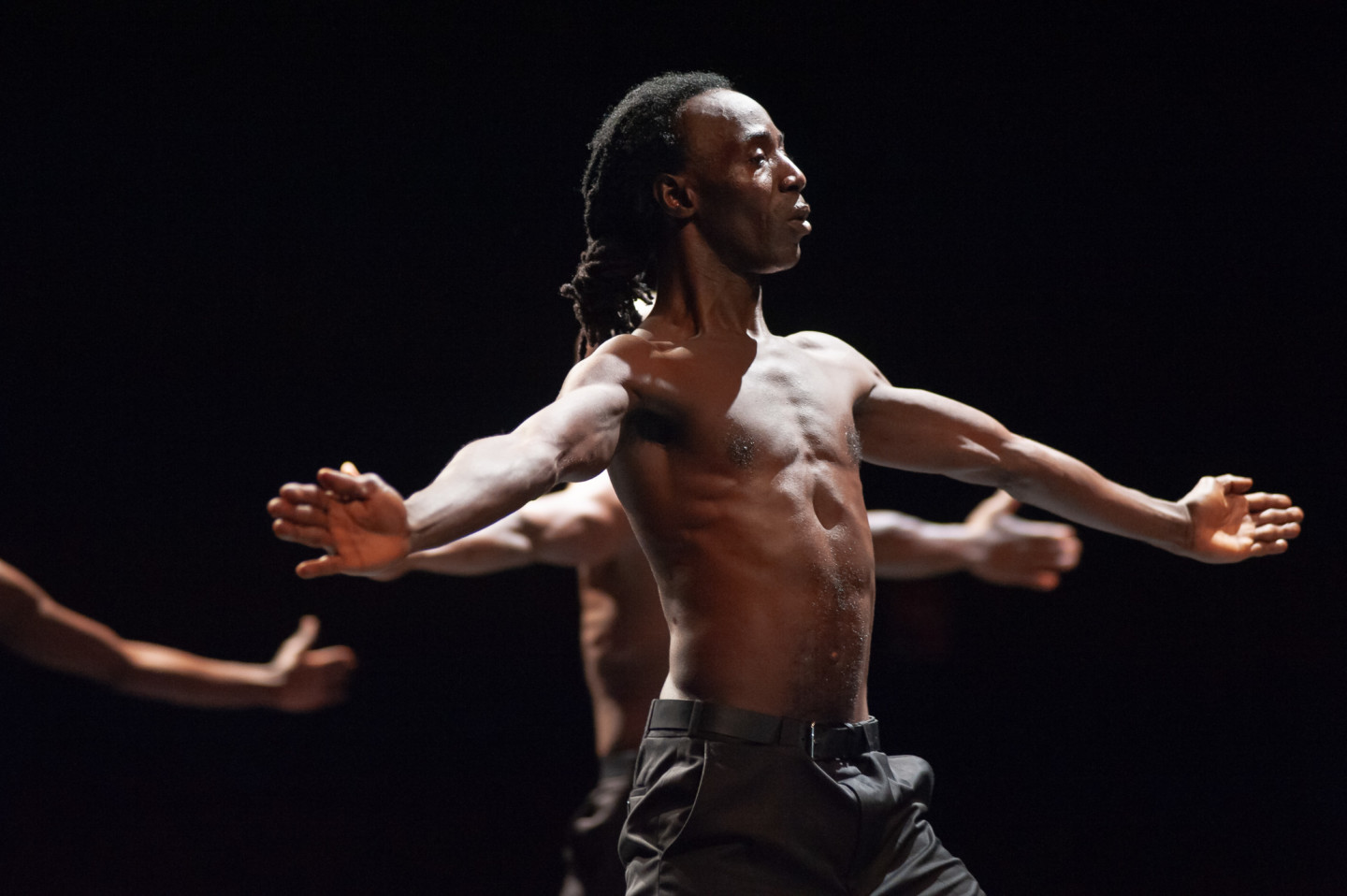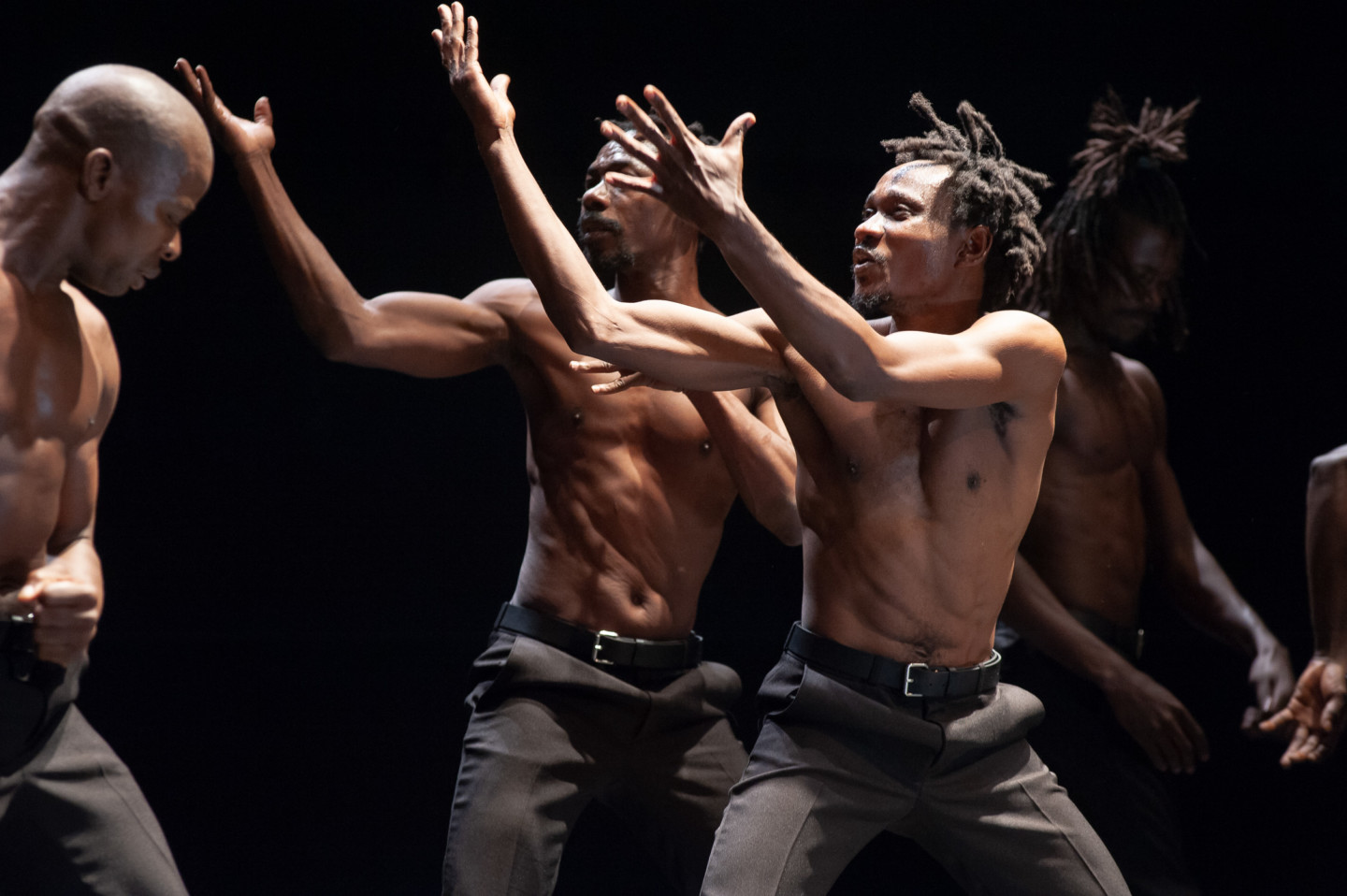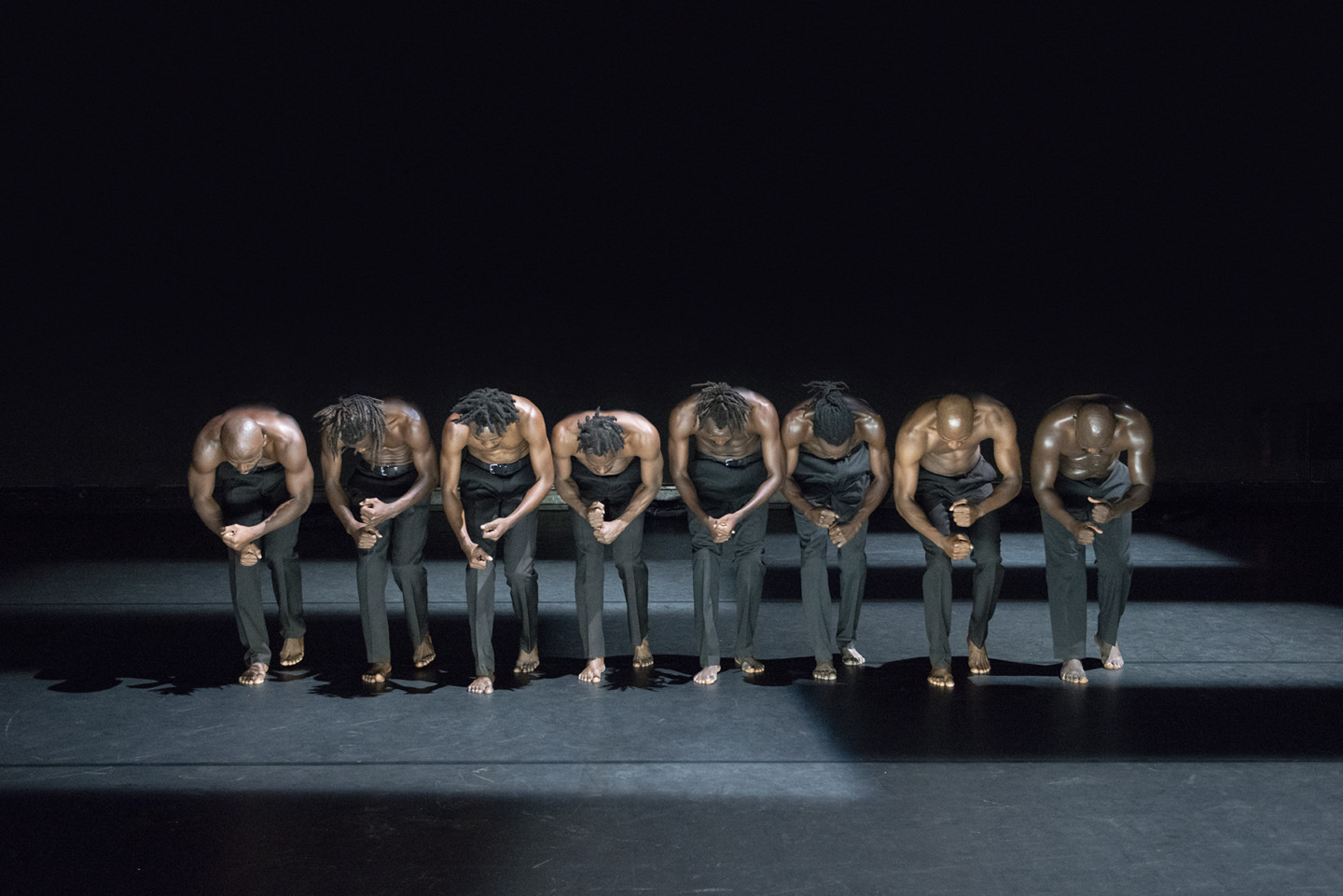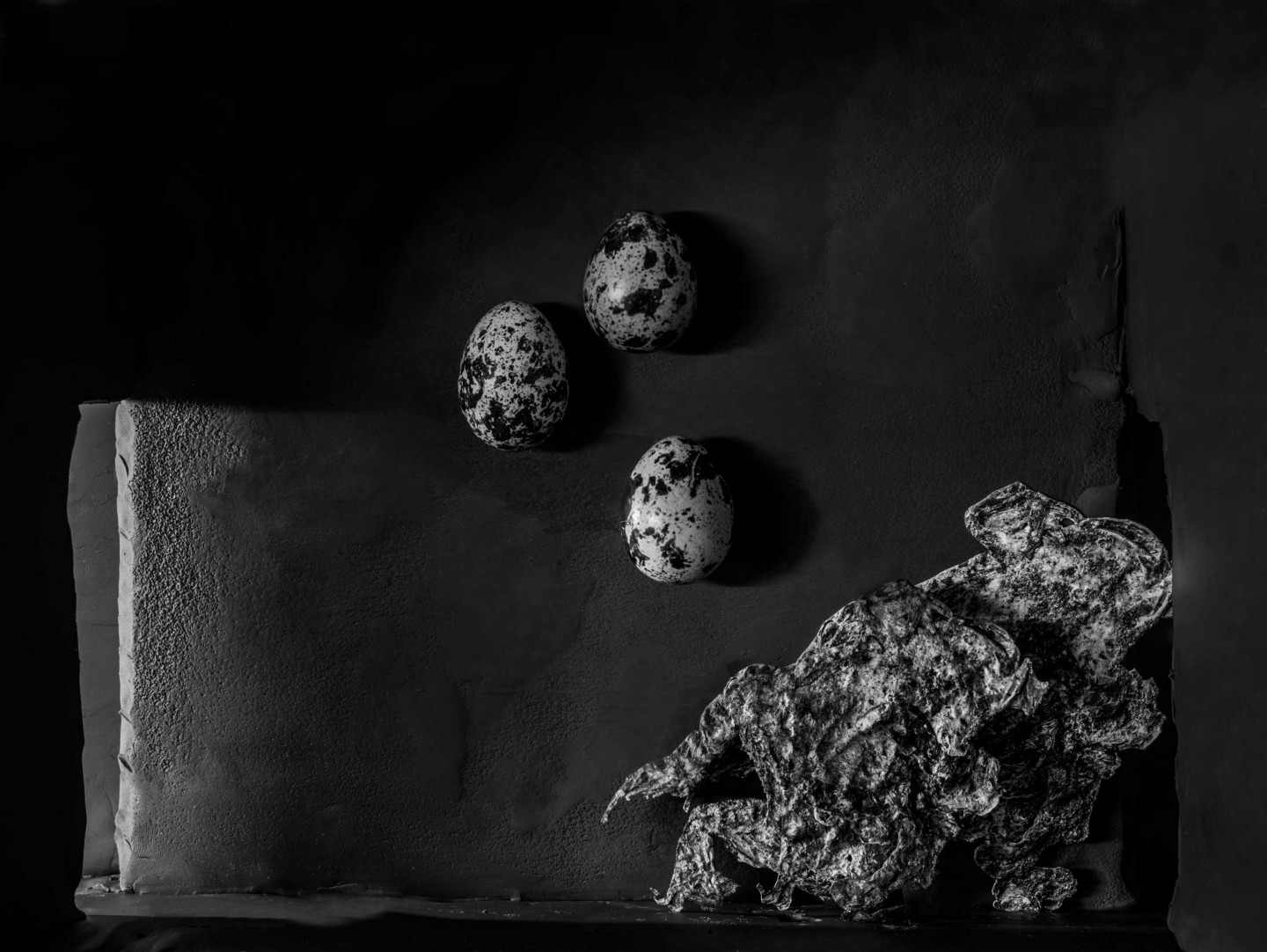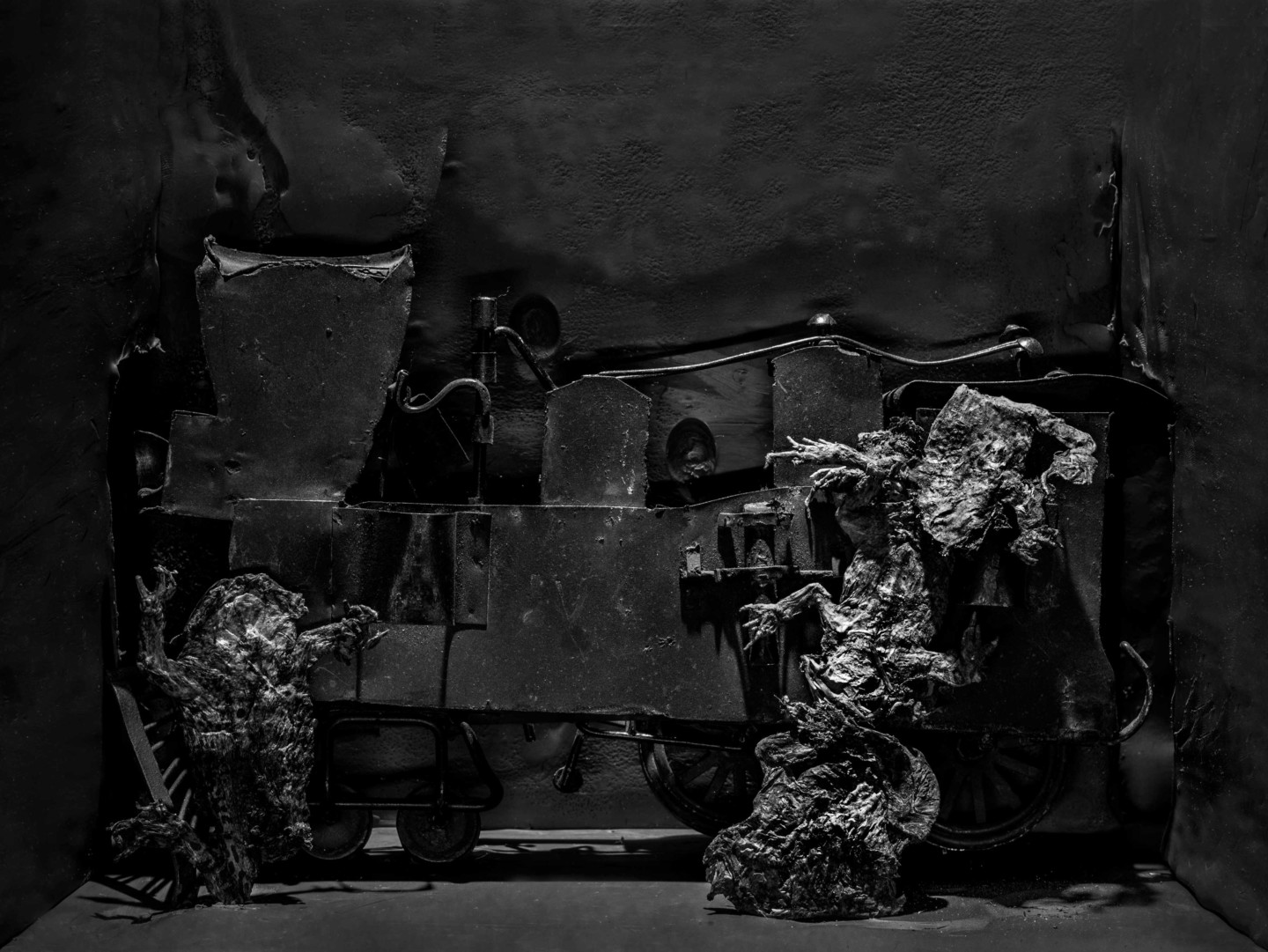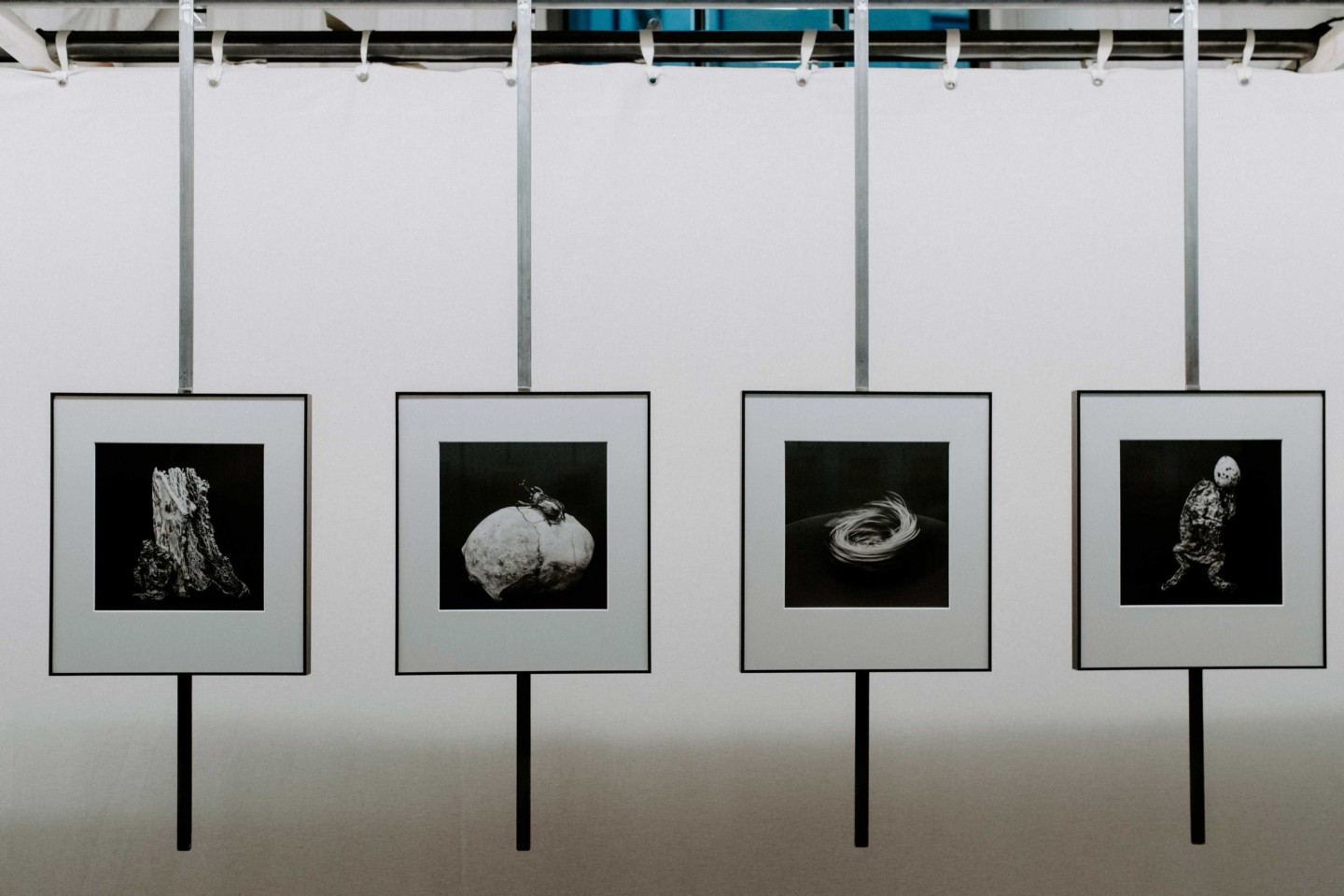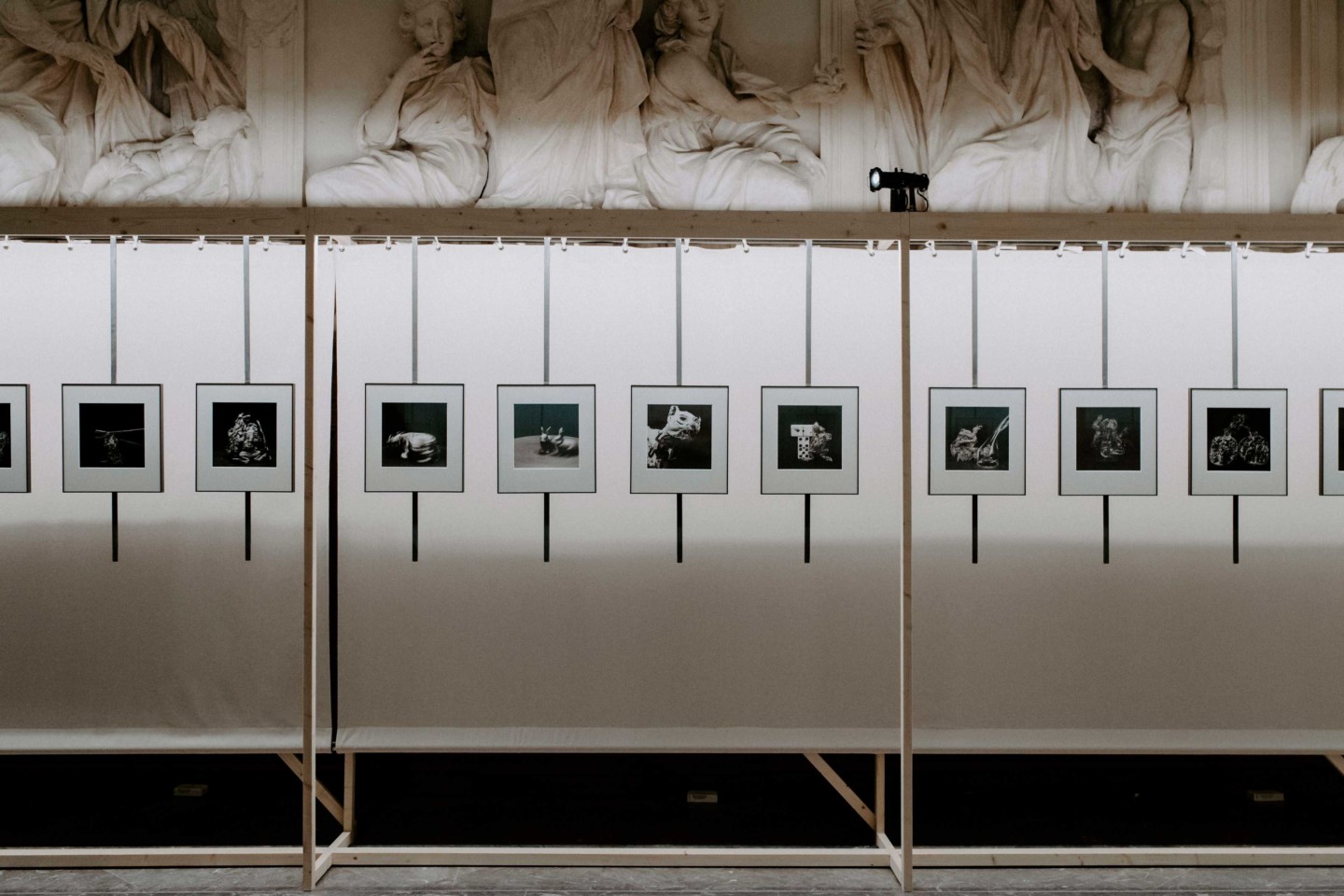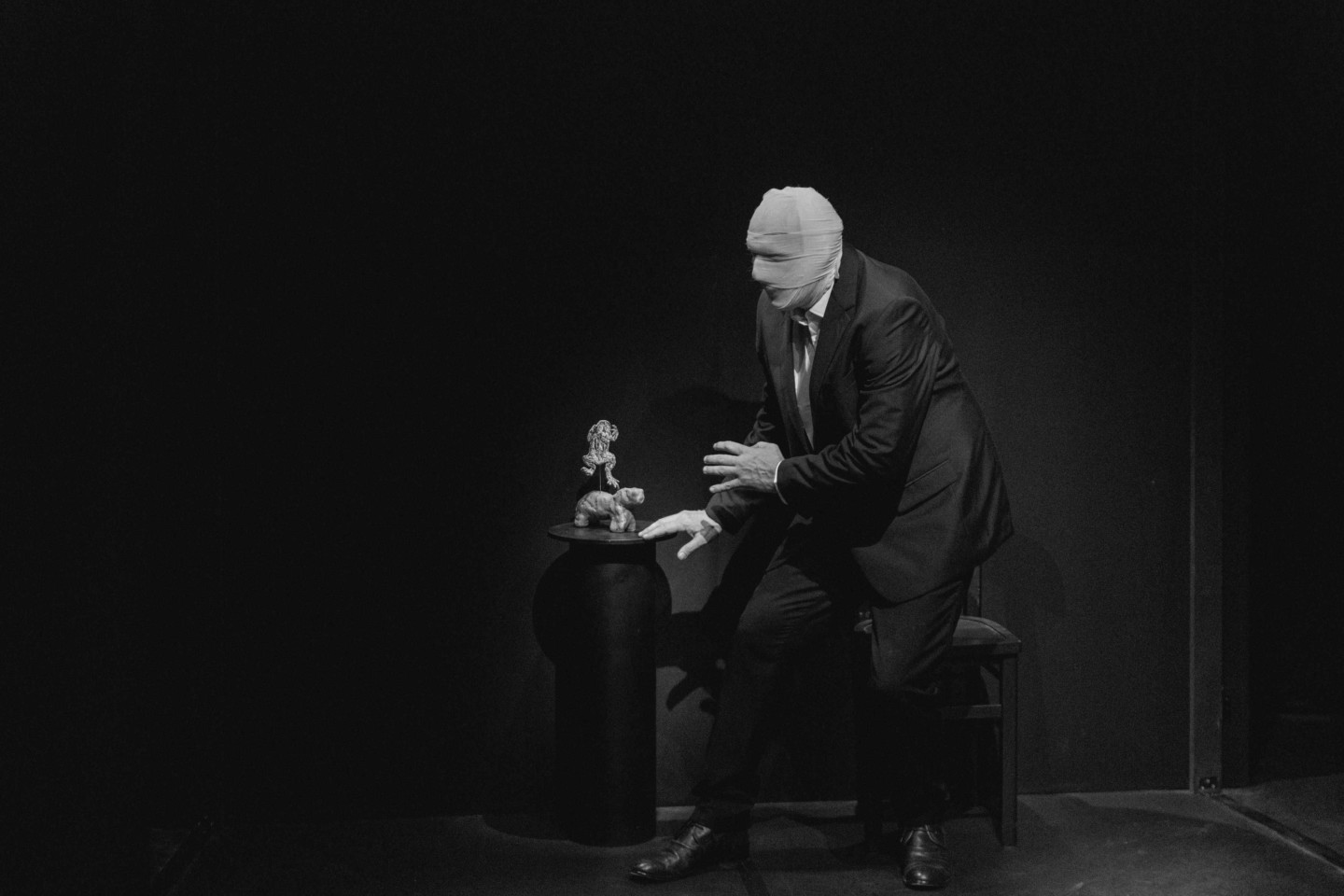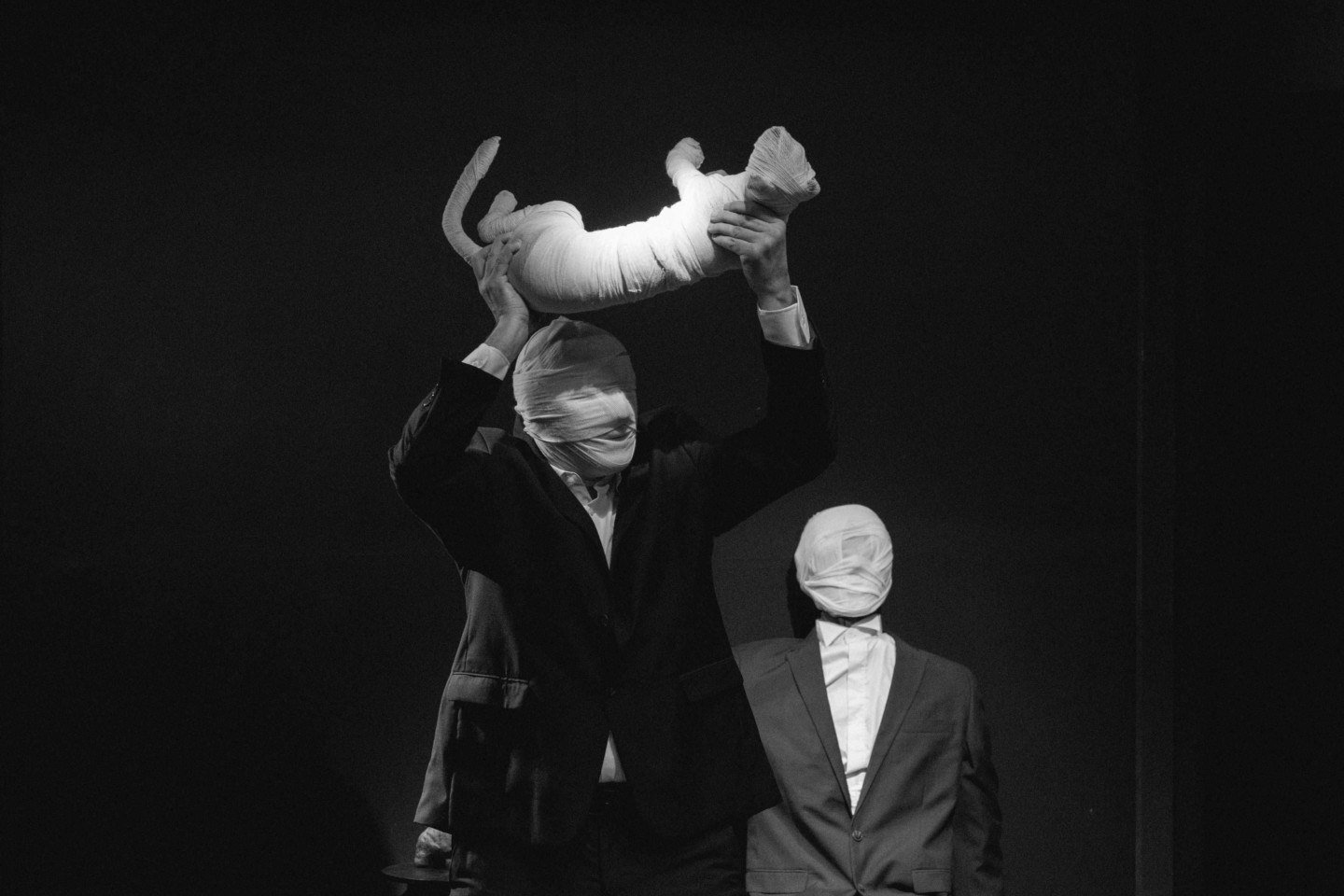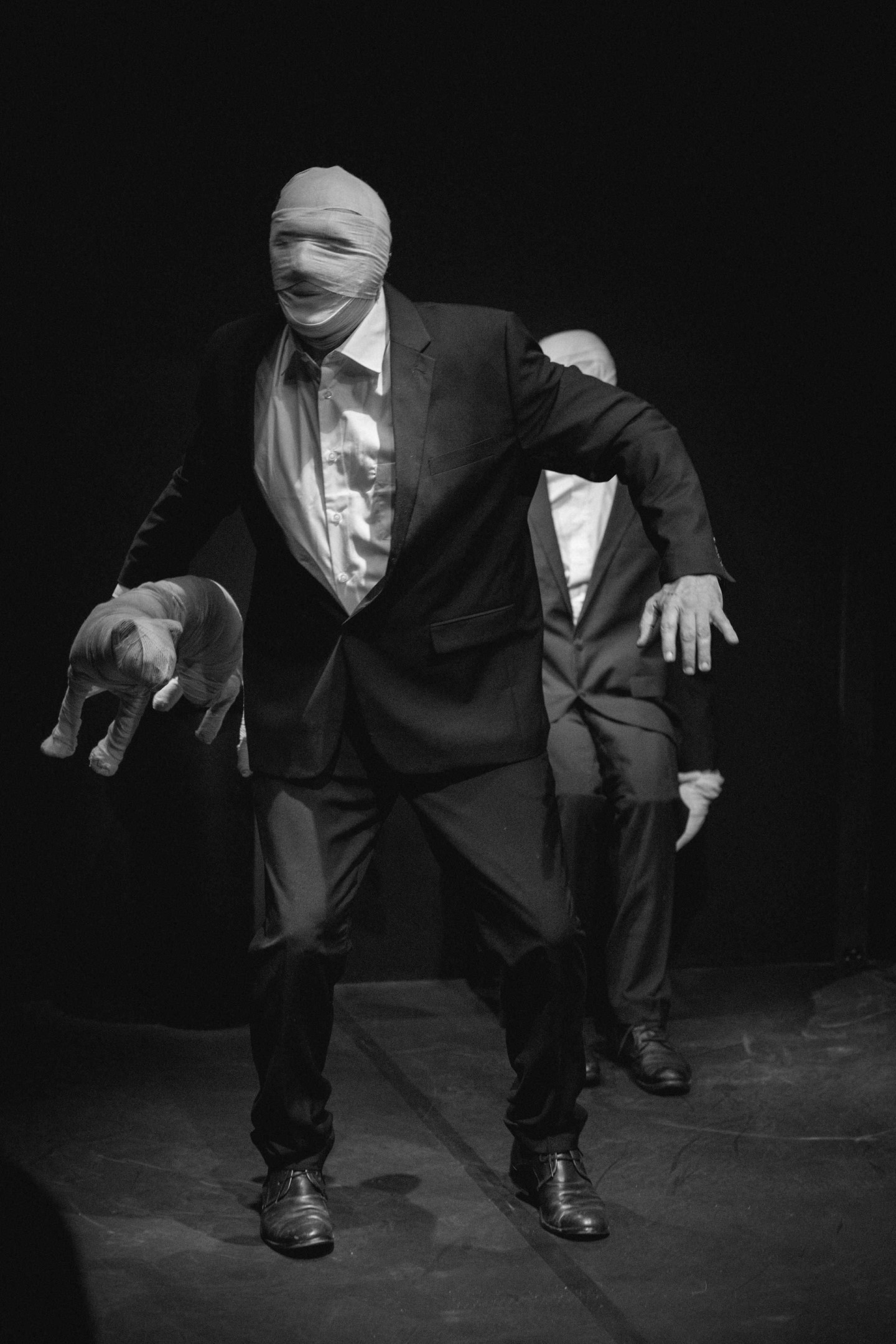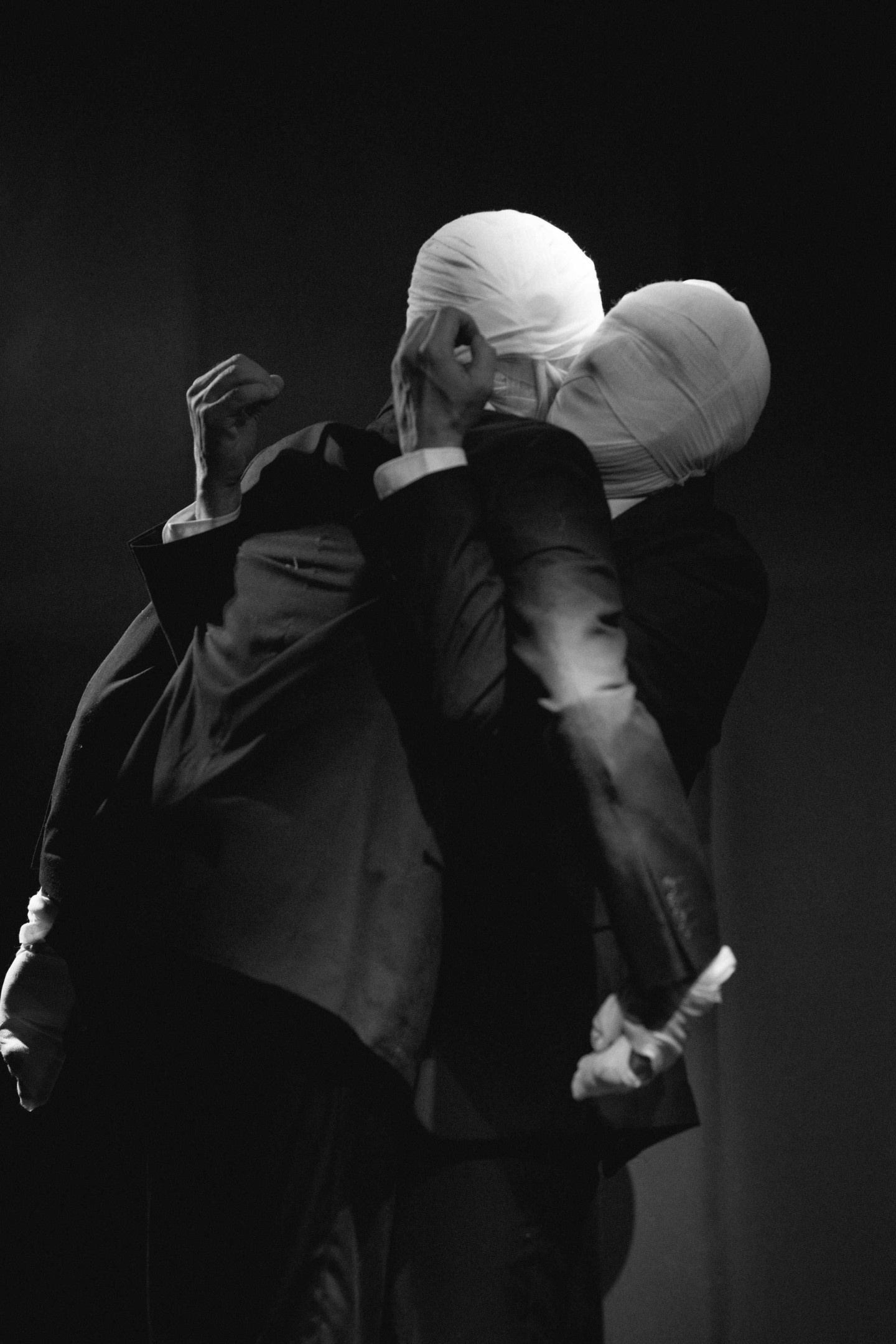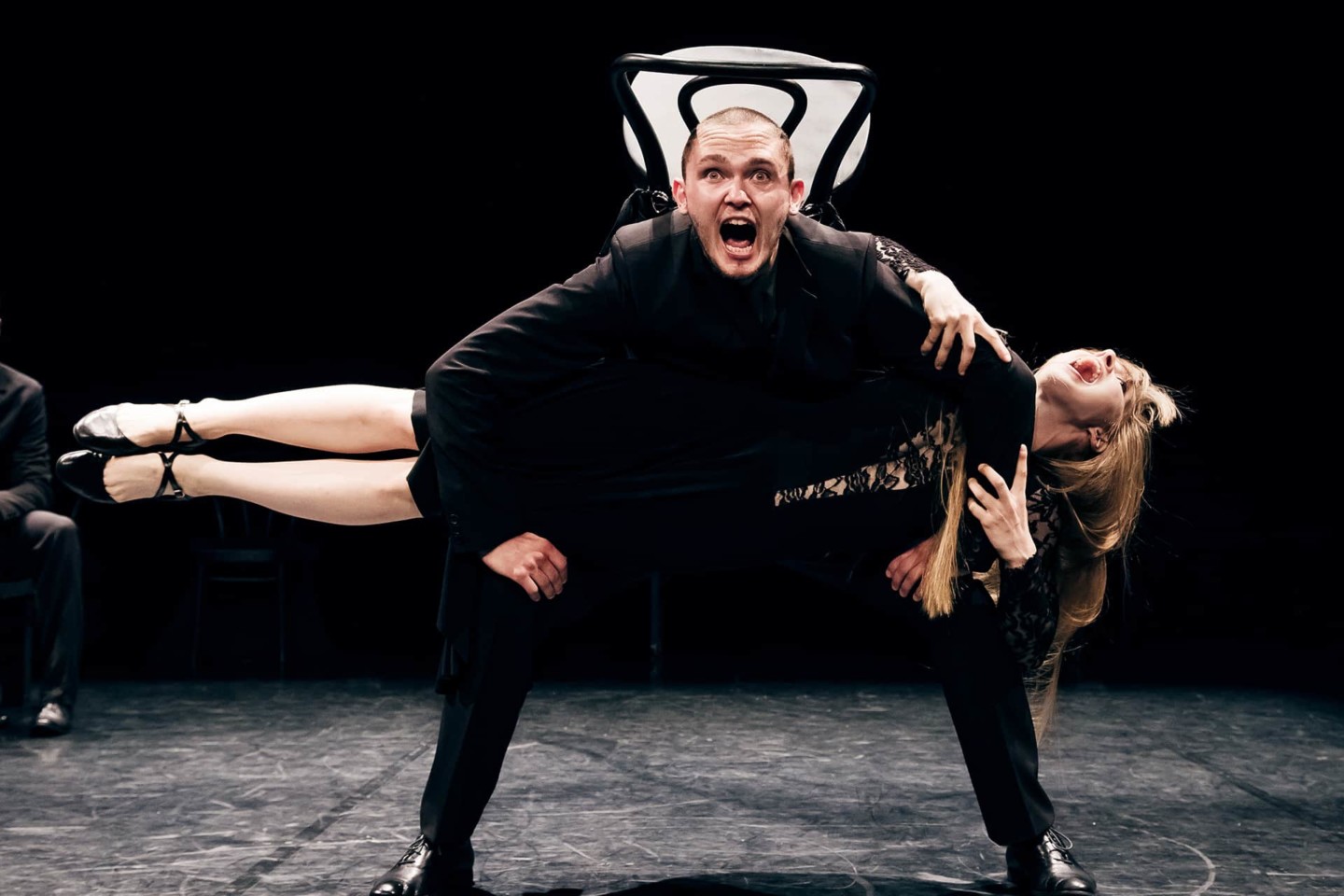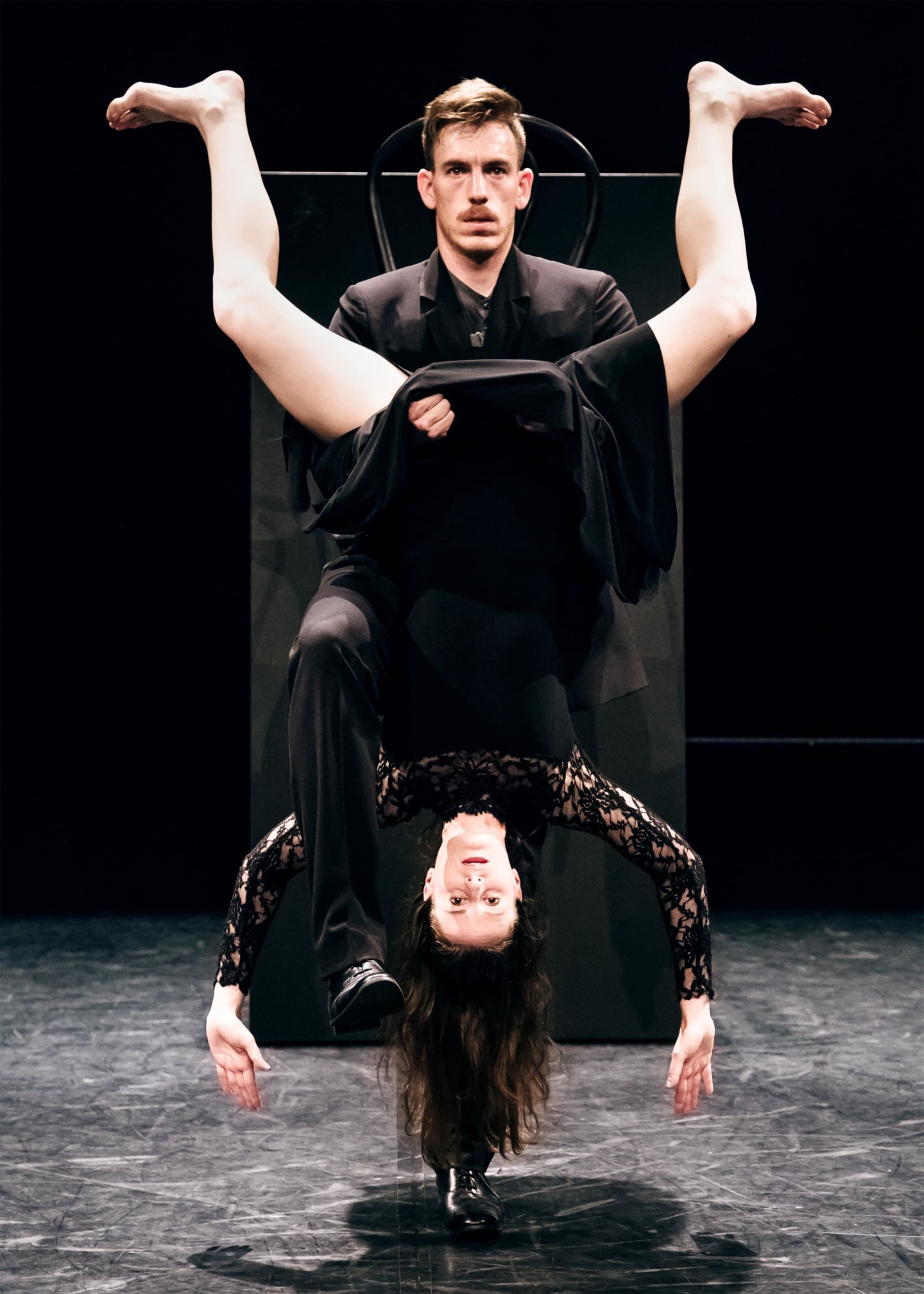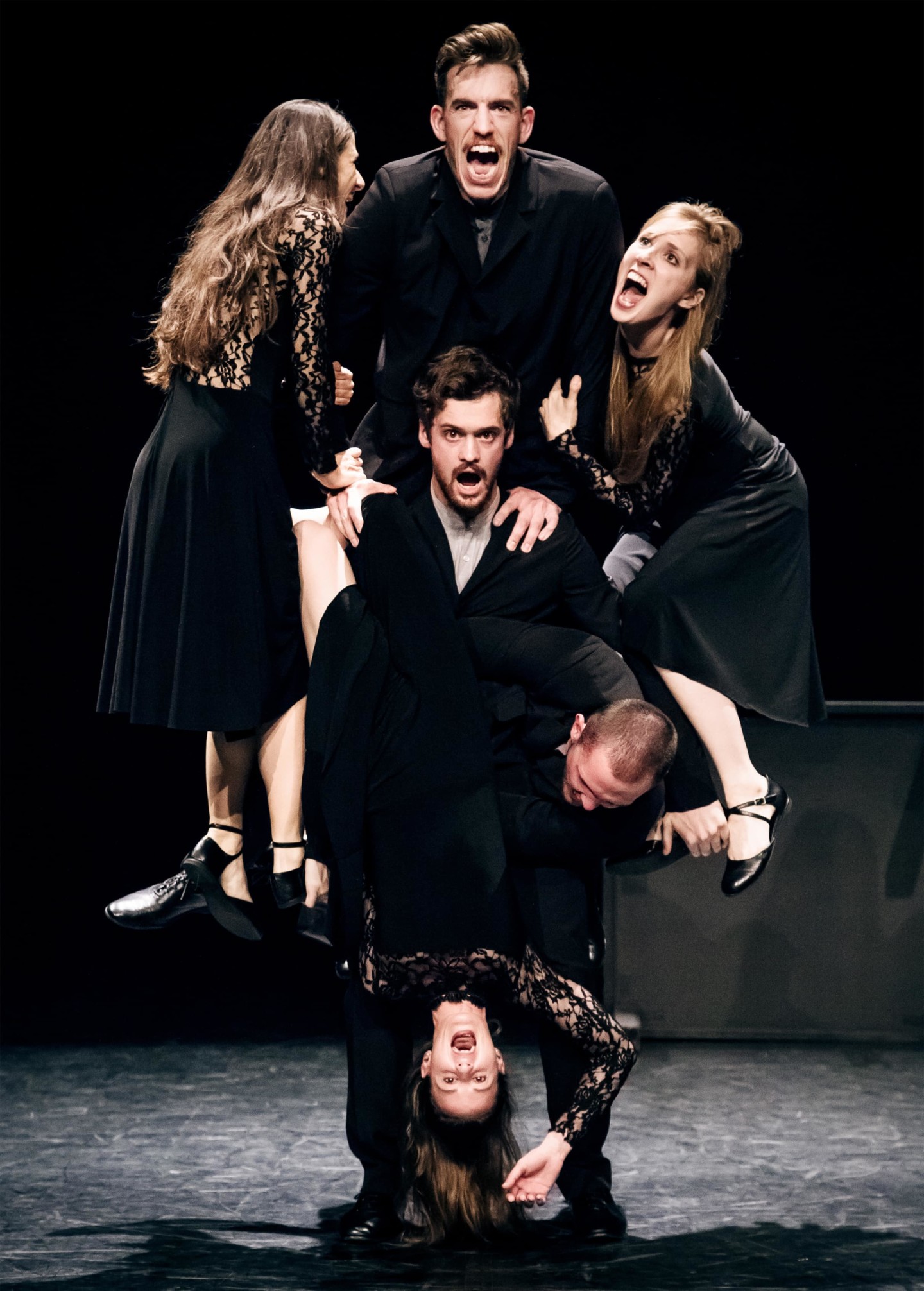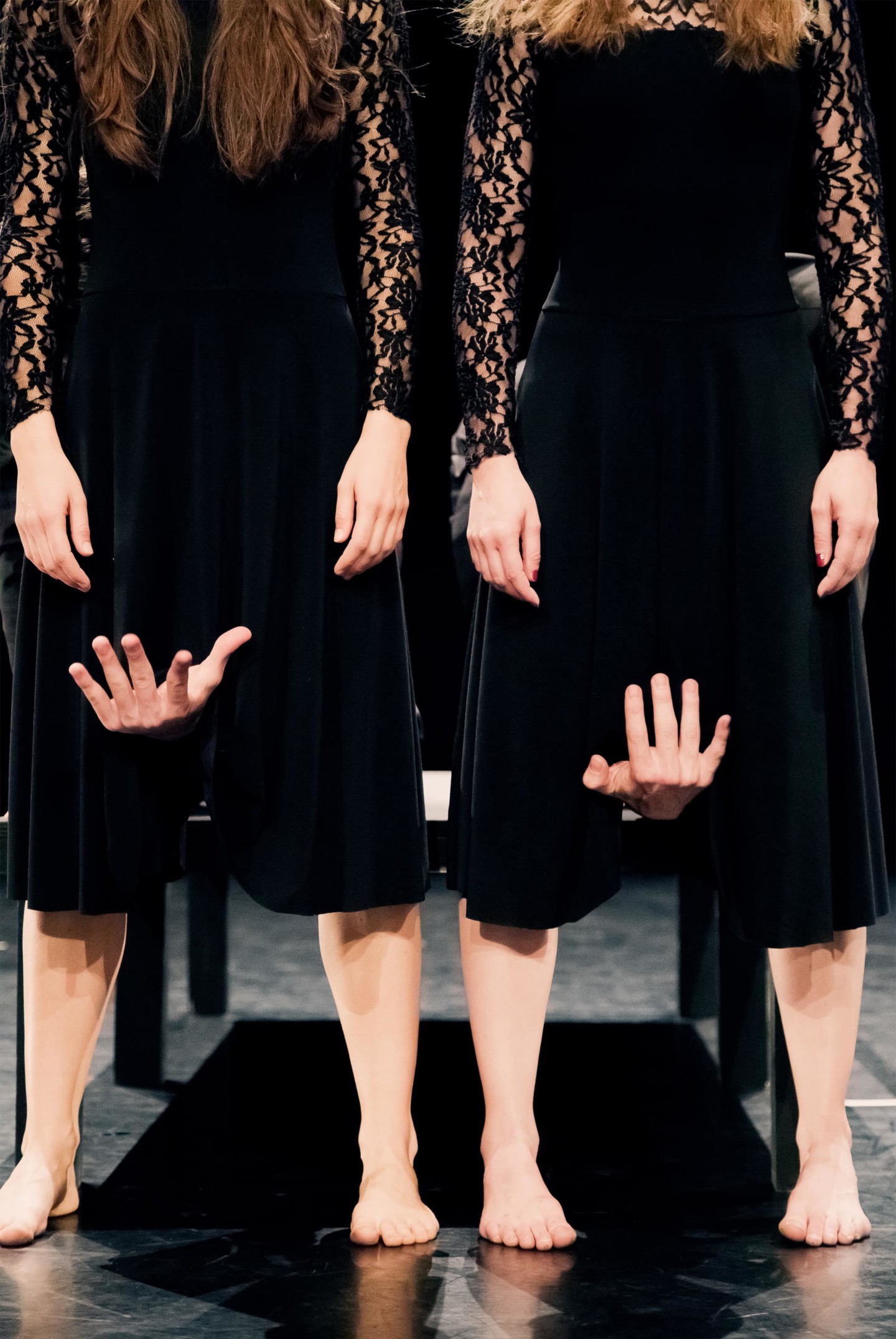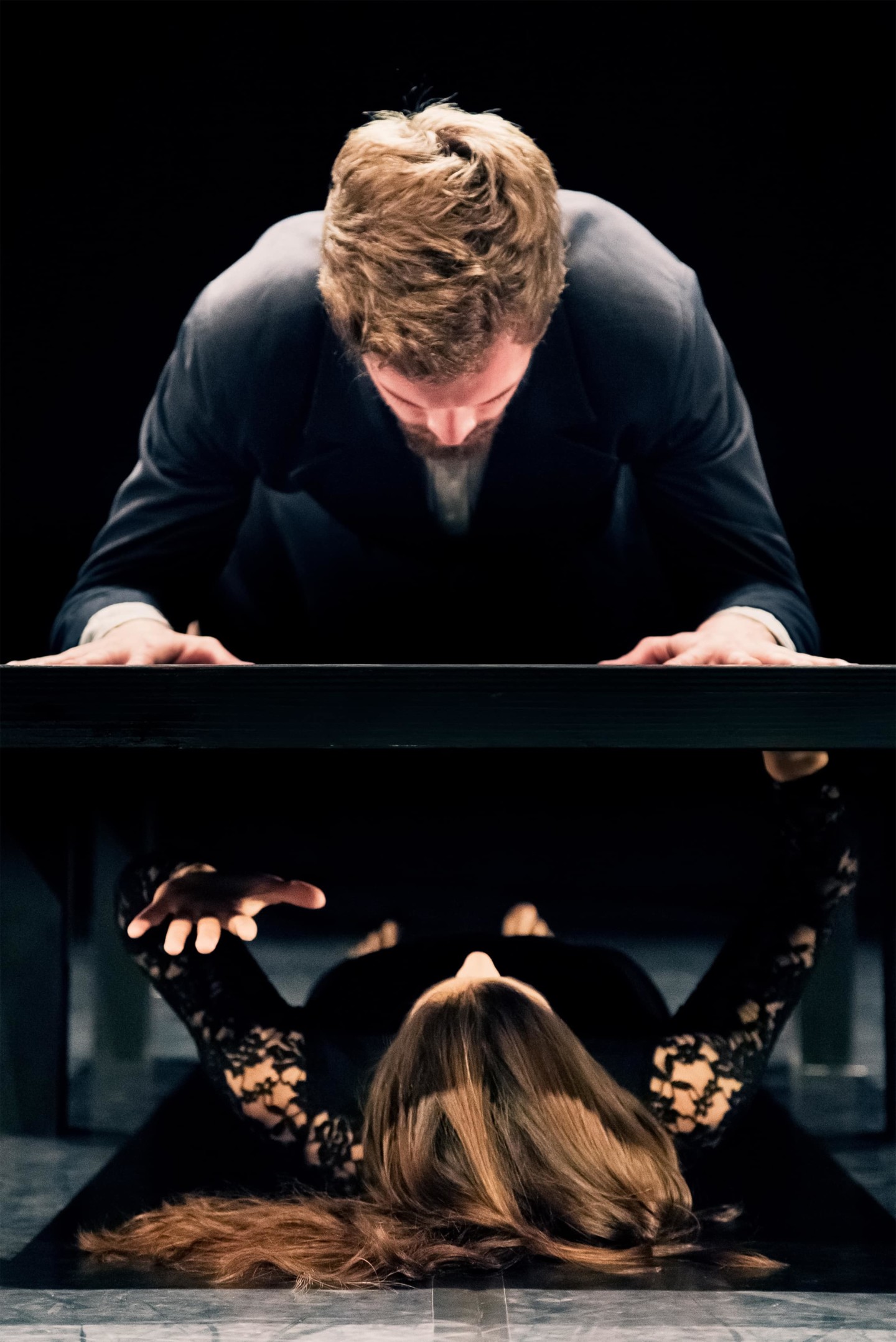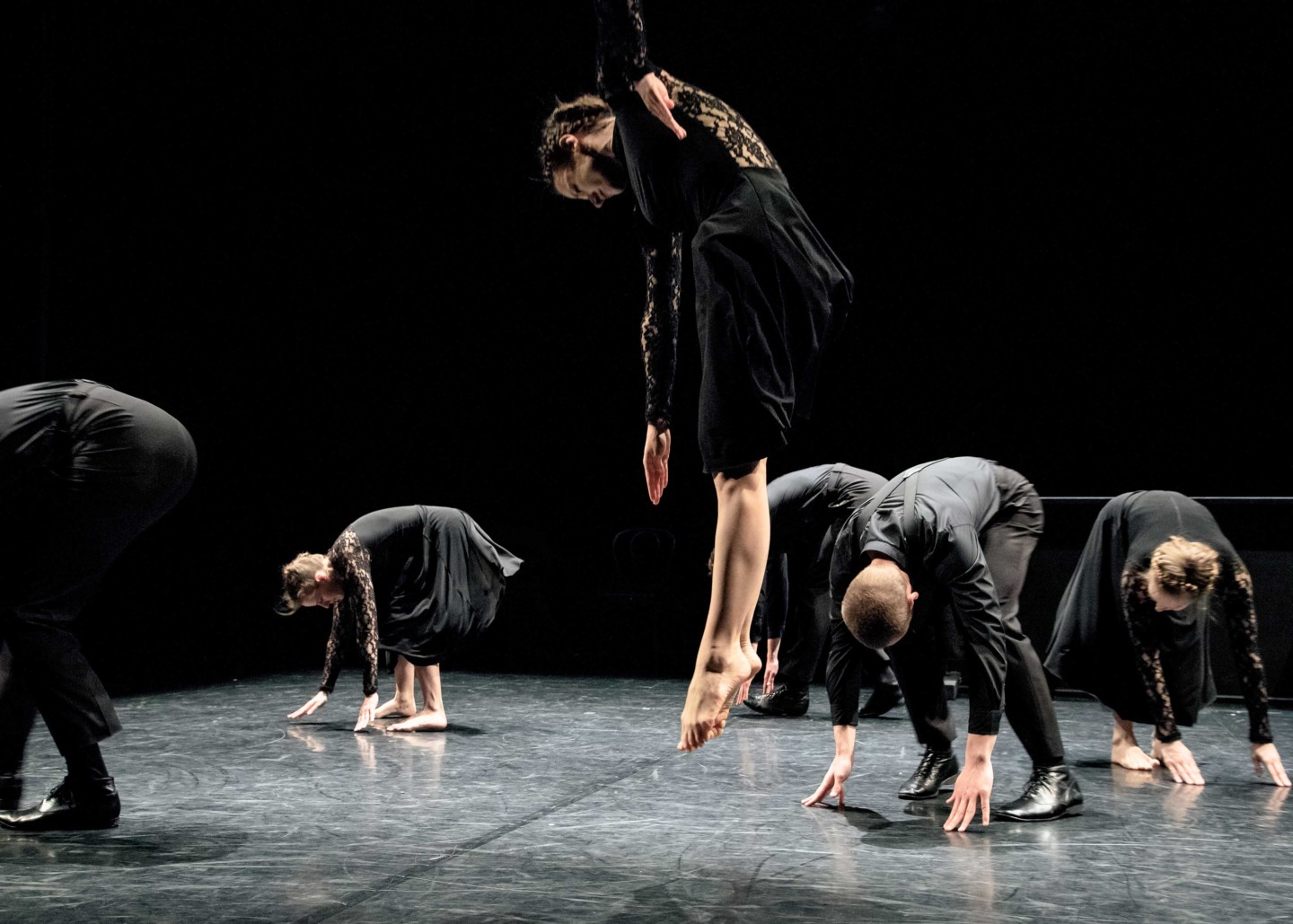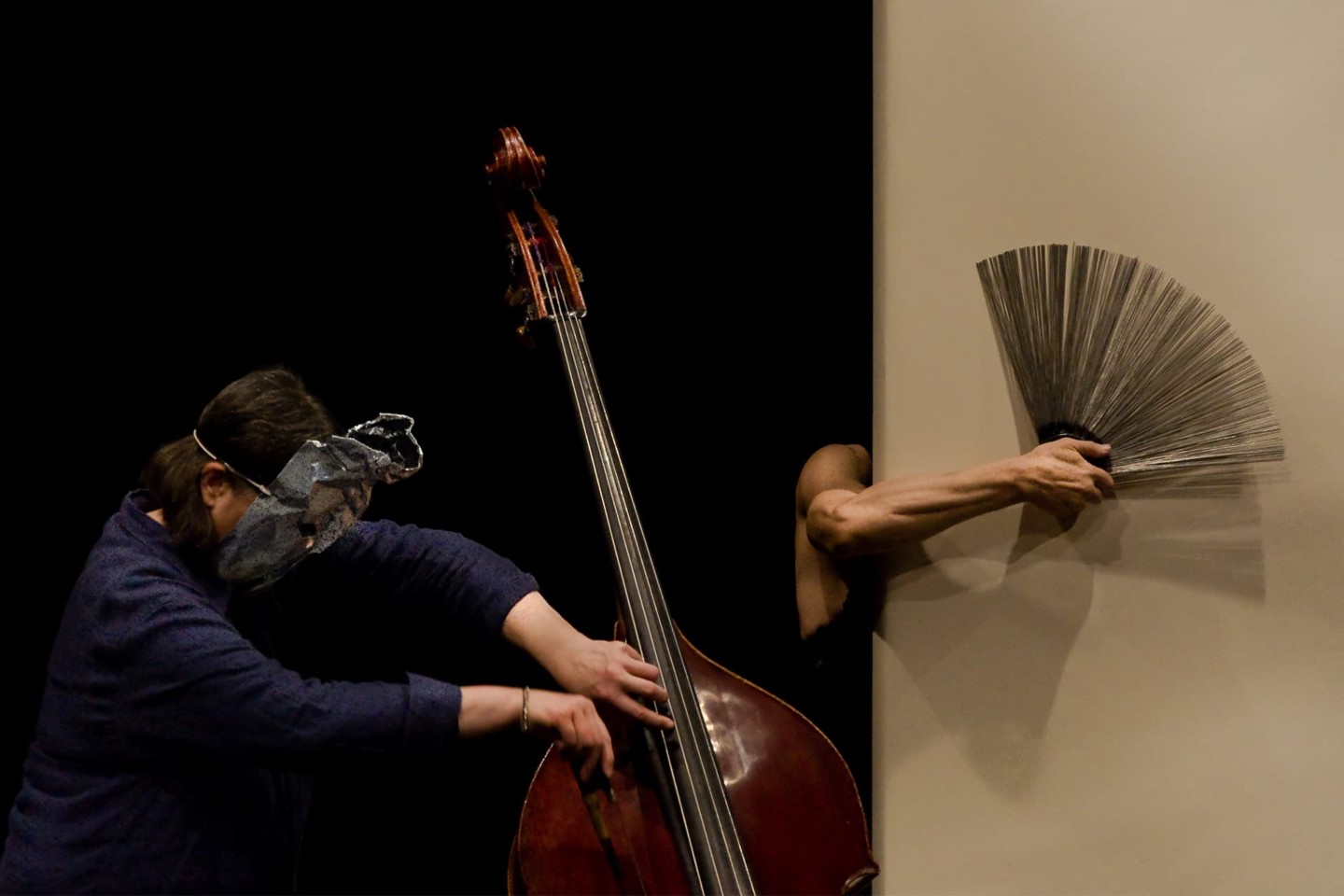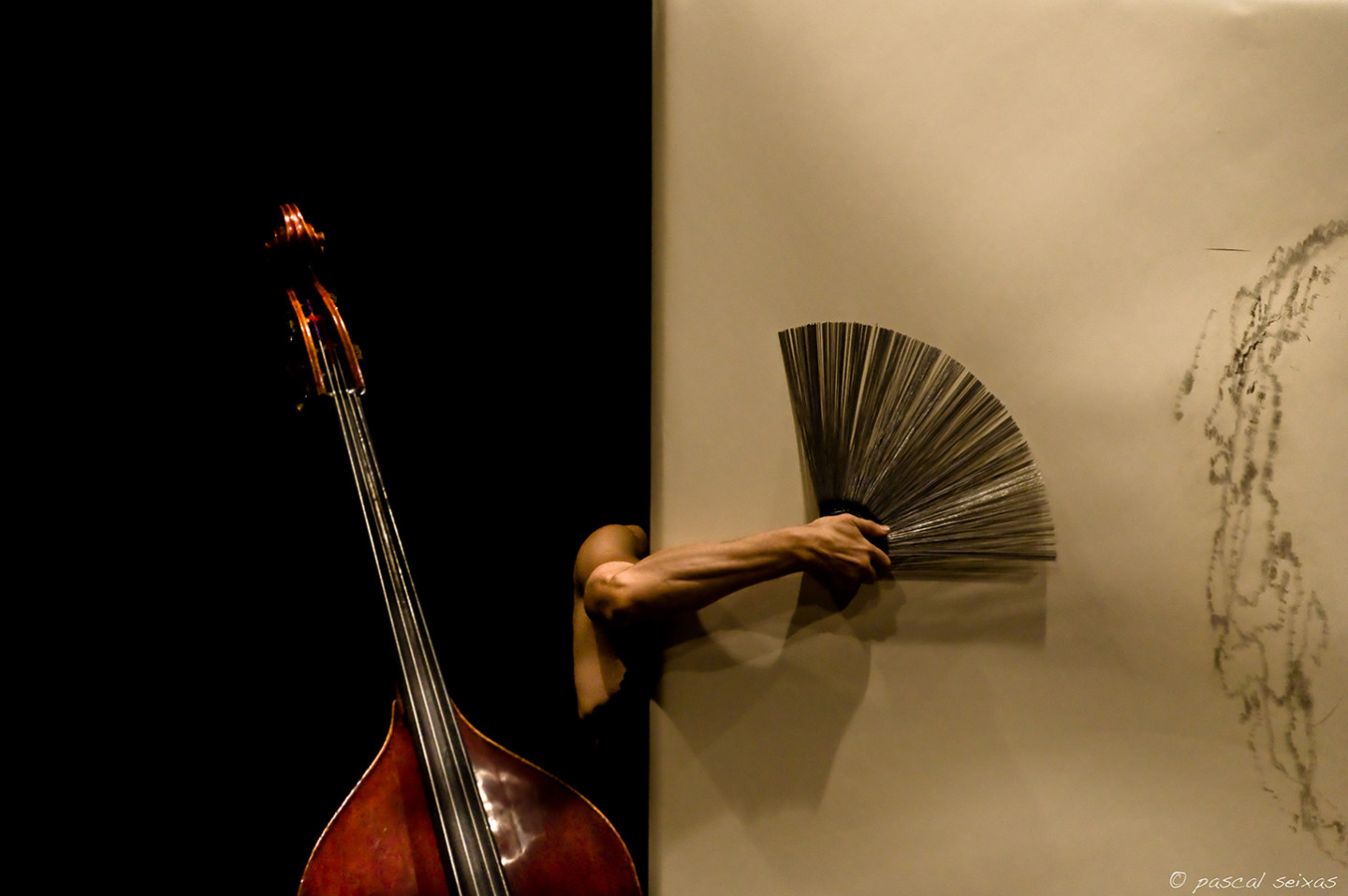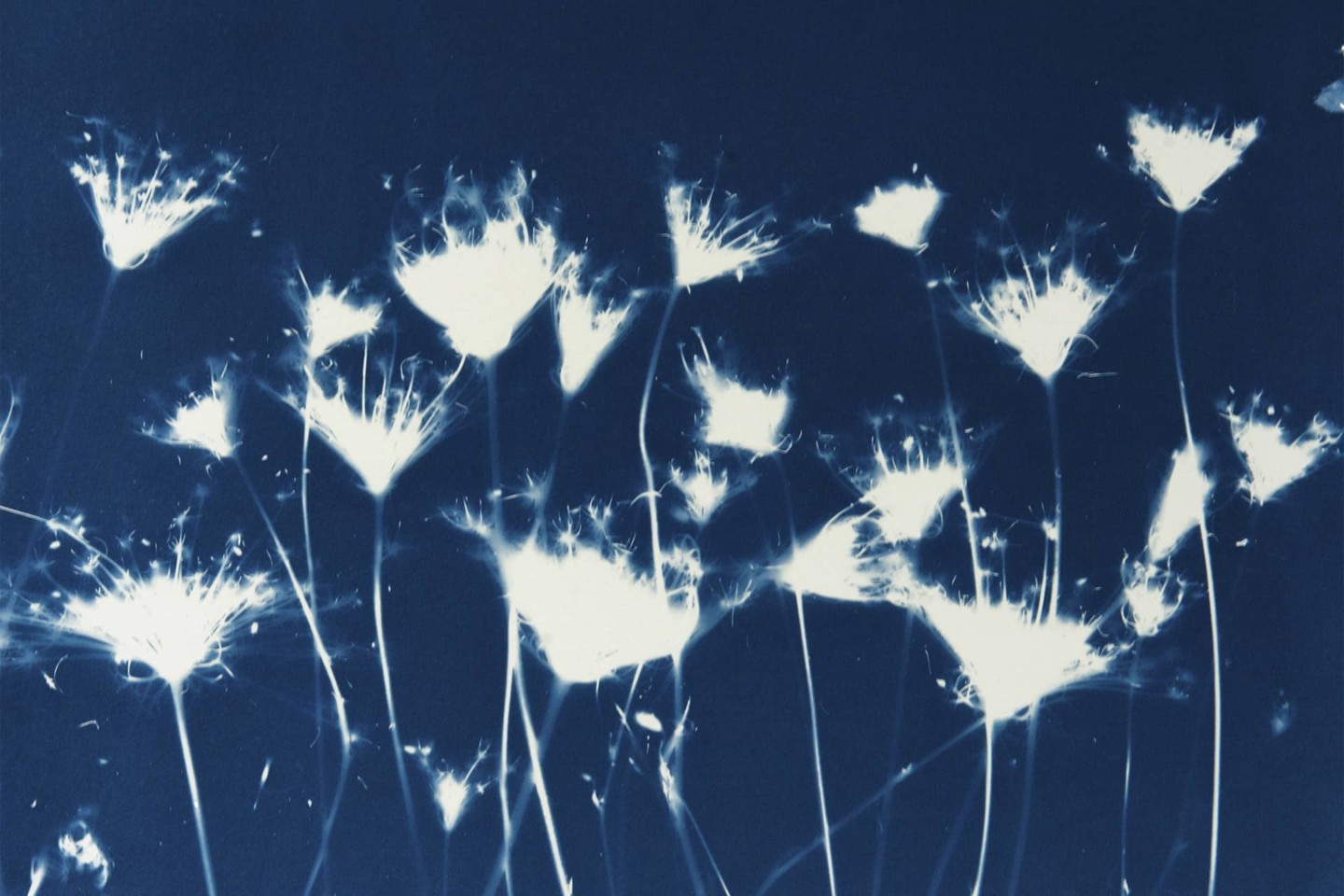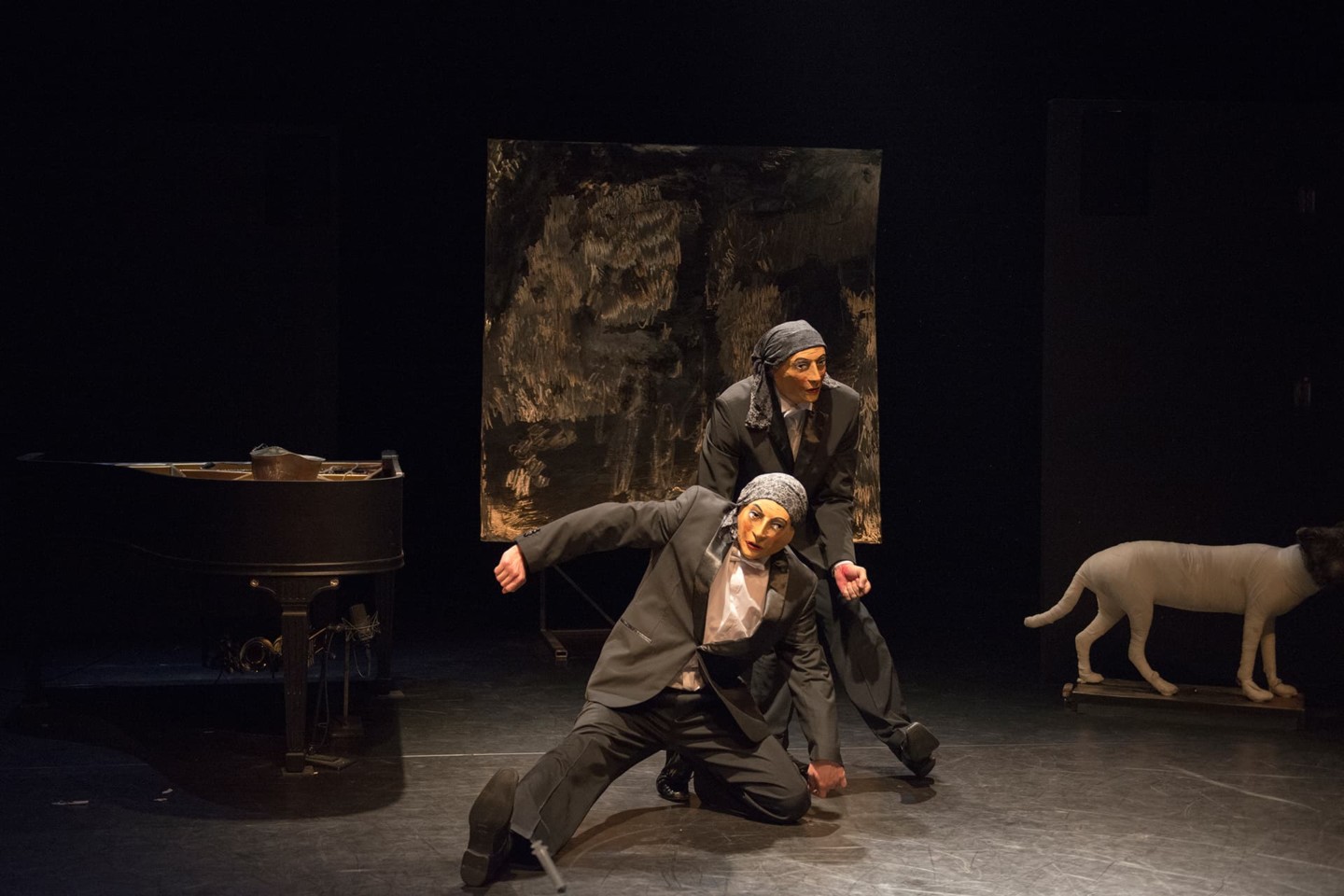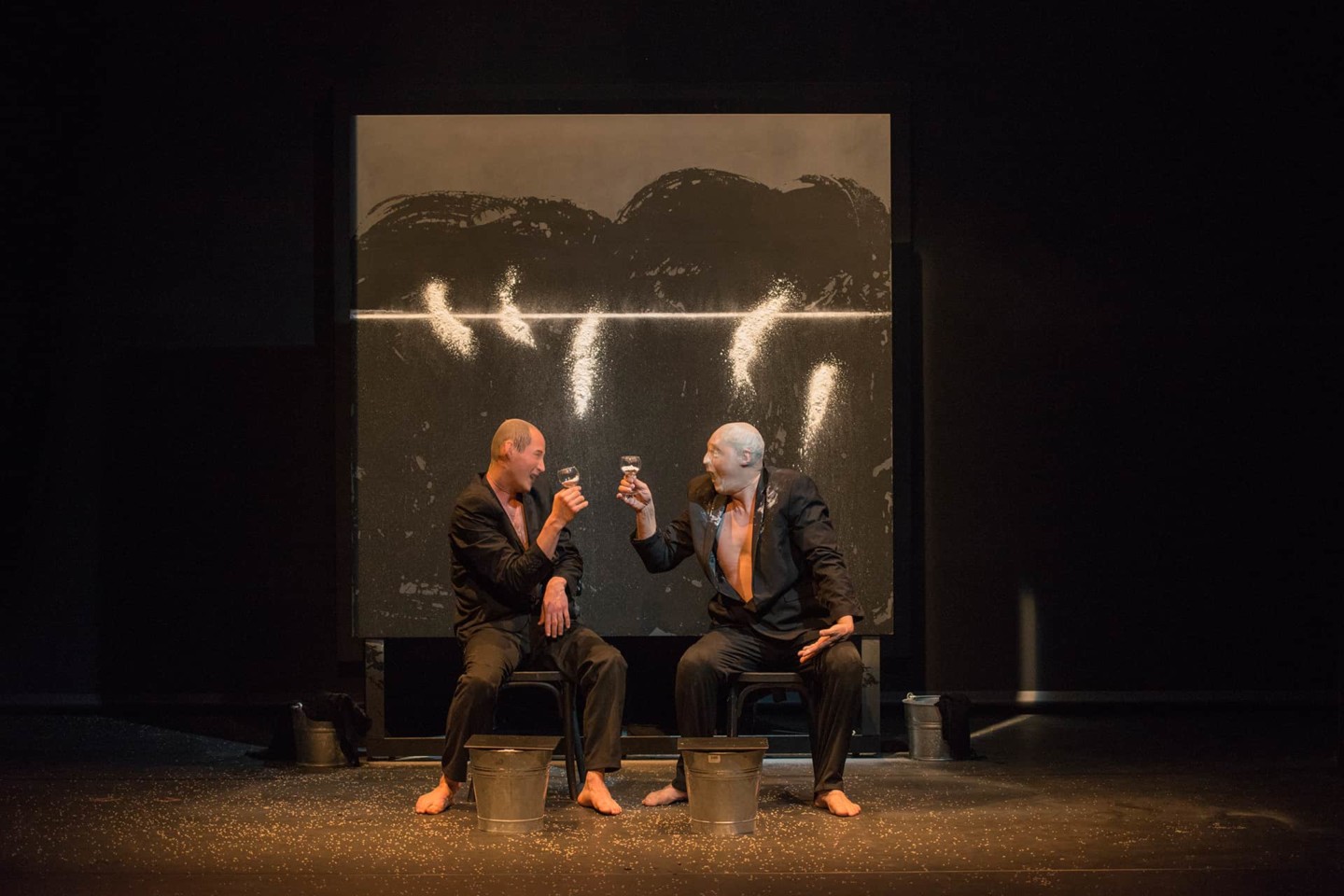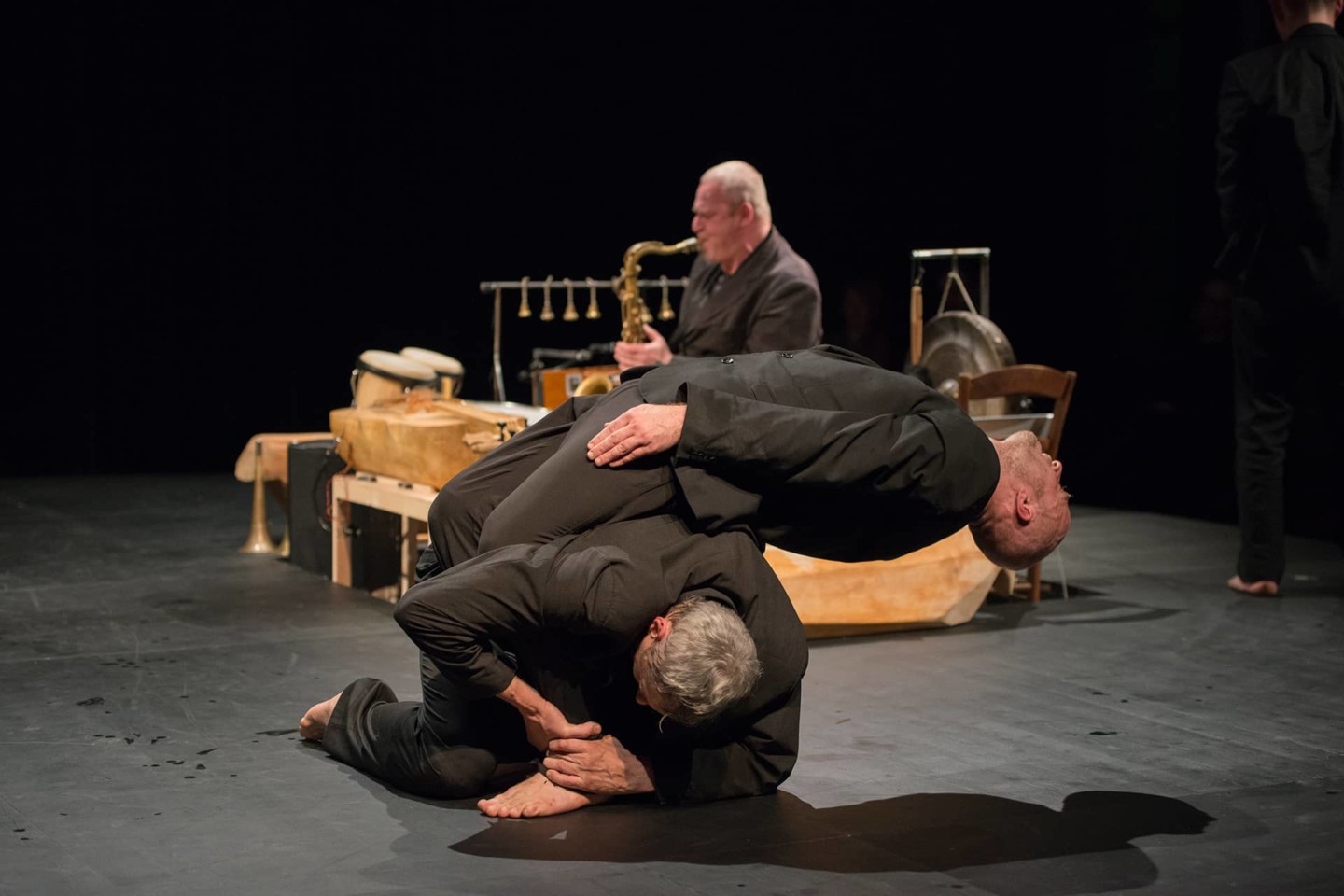Full Moon
Choregraphy
Josef Nadj
Interpreters
Timothé Ballo, Abdel Kader Diop, Aipeur Foundou, Bi Jean Ronsard Irié, Jean-Paul Mehansio, Sombewendin Marius Sawadogo, Boukson Séré et Josef Nadj
Artistic collaboration
Ivan Fatjo
Technical director and lights
Sylvain Blocquaux
Costums
Paula Dartigues
Musics
Fritz Hauser, Famoudou Don Moye & Tatsu Aoki, Art Ensemble Of Chicago, Malachi Favors Maghostut & Tatsu Aoki, Peter Vogel, Christian Wolfarth, Lucas Niggli
Production, Diffusion
Bureau Platô Séverine Péan et Mathilde Blatgé
Administration
Laura Petit
Executive production
Atelier 3+1
Coproductions
Montpellier Danse, Le Trident, Scène nationale de Cherbourg, MC 93 Maison de la culture de Seine-Saint-Denis, Bobigny, Charleroi Danse, Le Tropique Atrium, Fort-de-France, Théâtre des Salins, Scène nationale de Martigues, Le Théâtre d’Arles
Supports
Ministère de la Culture -DRAC Ile de France, Action financée par la Région Île-de-France, Teatroskop – un programme initié par l’Institut français, le ministère de la Culture et le ministère de l’Europe et des Affaires étrangères
Residences
With the support of Montpellier Danse 2024, creative residency at l’Agora, cité internationale de la danse, with support from Fondation BNP Paribas, CND – Centre National de la Danse à Pantin, Paris, Charleroi Danse, La Cocoteraie des arts, Mondoukou, Artus Studio, Budapest, Le Trident, Scène nationale de Cherbourg, MC 93 Maison de la culture de Seine-Saint-Denis, Bobigny (put in order, starting with the last)
With the support of la Maison des Métallos.
Full Moon follows Josef Nadj’s previous creation, Omma (2020), which was the fruit of research into the origins of dance, the origins of movement, carried out with eight dancers from Africa. Seven of them wanted to continue the adventure, and the choreographer once again encouraged them to delve deep within themselves, into their buried memories, to confront the rhythms and energies that constitute them – the rhythms and energies of the earth, of nature, as well as those of their respective cultures and traditions, thus affirming, within the group, the expression of their personal identity, the particularities of each.
In addition to this research into sources, Nadj also wished to explore another “track” for this creation: the world of black American jazz, from its original forms to the present day – a genre that has been appropriated by whites, and whose dance component has almost completely disappeared. He focused on the period from the late 1950s to the early 1980s, a period that particularly appeals to him. Contemporary with the African-American emancipation movement, this period saw a kind of intellectual and musical revolution take place in Chicago and New York, giving rise to free jazz and improvised music. Together with the dancers, Josef Nadj set about analyzing the forms specific to this music, extracting its spirit and thought, and searching for a dance that corresponded to it. Born of this “fascinating work”, Full Moon pays implicit tribute to some of the most eminent representatives of this movement: Charles Mingus, Cecil Taylor, Anthony Braxton and the Art Ensemble of Chicago.
Yet another figure is called upon in Full Moon, that of the puppet, which, like the mask, runs through all Josef Nadj’s work. Like the mask, the puppet runs through all of Josef Nadj’s work. The reason this figure, like the mask, recurs here is that both are very present in African cultures, but not only. Envisaged as the point of junction, the tipping point between the inert and the living, the animate and the inanimate, it carries another meaning than the “living” body, to which it provides a kind of counterpoint. But for Nadj, this figure also conveys the principle of life imprisoned in form. In this sense, the presence of the puppet, of the “puppet man” alongside the living, represents for him the fact that a creation is never perfect, and that it imposes the need to accept the game, even in its imperfection.
Myriam Blœdé
23.05.2024 2024
FESZT FESTIVAL
TIMISOARA (RO)
17.06.2024
FLOW FESTIVAL
SFANTU GHEORGHE (RO)
24,25 & 26.06.2024
MONTPELLIER DANSE
MONTPELLIER (FR)
12.07.2024
FESTIVAL DE ALMADA
ALMADA (PO)
18.07.2024
KALAMATA DANCE FESITVAL
KALAMATA
19.07.2024
KALAMATA DANCE FESITVAL
KALAMATA
23.07.2024
MITTELFEST
CIVIDALE DEL FRUILI (IT)
27.09.2024
THÉÂTRE D’ARLES
ARLES (FR)
03.10.2024
LE TRIDENT
SCÈNE NATIONALE DE CHERBOURG EN CORENTIN (FR)
04.10.2024
LE TRIDENT
SCÈNE NATIONALE DE CHERBOURG EN CORENTIN (FR)
12.10.2024
MESS FESTIVAL
SARAJEVO (BO)
17,18,19.10.2024
MC93
BOBIGNY (FR)
05.11.2024
THÉÂTRE DES SALINS
SCÈNE NATIONALE DE MARTIGUES (FR)
14.11.2024
LE NOUVEAU RELAX
CHAUMONT (FR)
19.11.2024
DESIRE CENTRAL FESTIVAL
SUBOTICA (SE)
20.11.2024
DESIRE CENTRAL FESTIVAL
SUBOTICA (SE)
25.11.2024
JOURNÉES THÉATRALES DE CARTHAGE
TUNIS (TU)
01.03.2025
SCENARIO PUBBLICO
CATANIA (SI)
02.03.2025
SCENARIO PUBBLICO
CATANIA (SI)
03.04.2025
LES THÉÂTRES DE LA VILLE DE LUXEMBOURG
LUXEMBOURG
04.04.2025
LES THÉÂTRES DE LA VILLE DE LUXEMBOURG
LUXEMBOURG
30.04.2025
THÉATRE ROMAIN ROLLAND
VILLEJUIF (FR)
16.05.2025
CHARLEROI DANSE
BELGIQUE (BE)
08.06.2025
NICOSIA MUNICIPAL THEATRE
NICOSIA (CY)
11.06.2025
RIALTO THEATRE
LIMASSOL (CY)
28.09.2025
GDANSK DANCE FESTIVAL
GDANSK (PO)
31.10.2025
CENTRE CULTURE FRANCO GUINEEN
CONAKRY (GU)
07.11.2025
INSTITUT FRANCAIS DE COTE D’IVOIRE
ABIDJAN (CI)
09.11.2025
COCOTERAIE DES ARTS
MONDOUKOU (CI)
14.11.2025
INSTITUT FRANCAIS DU BÉNIN
COTONOU (BE)
19.11.2025
INSITUT FRANCAIS DU TOGO
LOMÉ(TO)
22.11.2025
INSTITUT FRANCAIS DU SÉNÉGAL
DAKAR (SE)
04.11.2025
DE WARANDE
THURNOUT (BE)
23.01.2026
L’OCTOGONE, THÉATRE DE PULLY
PULLY (SU)
27.01.2026
LE GRAND ANGLE
VOIRON (FR)
28.04.2026
L’ESPACE DES ARTS
CHALON SUR SAONE (FR)
16.05.2026
TEATRO DI NAPOLI, TEATRO MERCADANTE
NAPOLI (IT)
17.05.2026
TEATRO DI NAPOLI, TEATRO MERCADANTE
NAPOLI (IT)
Omma
Choregraphy
Josef Nadj
Performers
Timothé Ballo, Abdel Kader Diop, Aïpeur Foundou, Bi Jean Ronsard Irié, Jean-Paul Mehansio, Marius Sawadogo, Boukson Séré – Djino Alolo Sabin (2021-2023)
Artistic collaboration
Ivan Fatjo
Lights
Rémi Nicolas
Soundtrack
Tatsu Aoki & Malachi Favors Maghostut, Peter Brötzmann & Han Bennink, Eureka Brass Band, Jigsaw, Lucas Niggli, Peter Vogel
Technical direction
Sylvain Blocquaux
Sound engineer
Ivan Fatjo or Steven Le Corre
Coproductions
Les Nuits de Fourvière, Festival International de la Métropole de Lyon | Les Théâtres de la Ville de Luxembourg | Le Trident, Scène Nationale de Cherbourg-en-Cotentin | MC 93-Maison de la Culture de Seine-Saint-Denis | La Comédie de Valence, Centre dramatique national Drôme-Ardèche | Charleroi danse, centre chorégraphique de Wallonie – Bruxelles | Le Grand Angle, Scène régionale du pays voironnais | Les Salins, Scène nationale de Martigues | Centre chorégraphique national de Tours / Thomas Lebrun (Accueil studio) | Théâtre des Quatre Saisons – Scène Conventionnée d’intérêt national «Art et Création»
Supports
Ministère de la Culture – Direction régionale des affaires culturelles d’Ile-de France | Région Ile-de-France | l’Institut Français et le programme Teatroskop (programme initiated by the French Institut, the Ministry of Culture and Ministry of Europe and Foreign affairs) | Angers – Centre National de Danse Contemporaine | CN D – Centre national de la danse | La Briqueterie – CDCN du Val-de-Marne | la Scène nationale d’Orléans
Creation
The premiere of OMMA was originally scheduled at Festival Les Nuits de Fourvière – Lyon, 25-27th june 2020 and canceled due to the Covid-19 pandemic. OMMA eventually premiered on the 9th and 10th february 2021 in the Grand Théâtre – Les Théâtres de la Ville de Luxembourg.
There are eight of them, in jackets and black trousers, a nod to Josef Nadj’s timeless silhouette. In lending them his costume, he commits each dancer not to walk in his footsteps, but to reveal his own singularity. Above all, OMMA is a story of sharing and passing on.
In this new work, the Hungarian choreographer has put together a group of eight dancers hailing from Mali, Senegal, Cote d’Ivoire, Burkina Faso, Congo Brazzaville and the Democratic Republic of Congo. The piece is steeped in as many influences, movements, cultures and stories. Together, they form one single body – black, or fekete, as they proclaim… in Hungarian. A plural body in which each affirms his own language, identity, his own dance : a captivating feedback loop between group and individual that leads us, inevitably, to the human being as universal.
A true ensemble took shape during a creative process full of trust, sharing and respect, so much so that the audience cannot ignore each performer’s pleasure and generosity or the harmony emanating from the collective. OMMA’s strength lies in the involvement of the group and the truthfulness of the piece they created together. For Josef Nadj, it was necessary to focus on bodies and movement, keeping only what is essential. This principle of simplicity extends both to the stage itself, kept deliberately bare, and to the sound design- a world of breaths, voices, silences and heady jazz rhythms. Onstage, bodies, light, and sound are enough, without artifice.
Can the piece be called organic? OMMA undoubtedly hails back to the roots of dance, with movement as its essence and the universe as its horizon. In other words, OMMA is a choreographic origin quest, seeking to demonstrate Josef Nadj’s hypothesis: dance was born alongside humanity. And if so, does going back to the source of dance and movement not equate to going back to the origin of the universe? It is with this in mind that the choreographer shapes the raw materials provided by his dancers and constructs with them and their bodies a dance that is shared, plural, and resolutely universal.
Josef Nadj has embarked his artists on a voyage to the roots of dance that might reveal the equilibrium of our universe. Echoing the circle of life, this new choreographic piece looks into something essential: our ability to look at what’s in front of us so we can better see what lies deep within us, in a common destiny. Hence, OMMA’s ancient Greek meaning shines new light: ‘eye’ but also ‘what is seen or looked at’. There lies an invitation to keep our senses awake so we can better capture this dance, dedicated to the genesis of humanity.
Marylène Malbert
Season 2023/2024 under construction
Past performances :
09 > 10 february 2021 – PREMIERE !
Les Théâtres de la ville de Luxembourg
Luxembourg (LU)
09> 10 june 2021
Les Nuits de Fourvière – in complicity with the Biennale de la danse de Lyon
Lyon (FR)
09> 11 july 2021
Festival de Almada
Almada (PT)
17 july 2021
la Scène nationale d’Orléans
Orléans (FR)
29 > 30 july 2021
Biennale di Venezia
Venice (IT)
23 > 24 august 2021
FITS – Sibiu International Theater Festival
Sibiu (RO)
12 september 2021
FIAT – Festival of international alternative theater
Podgorica (ME)
15 > 16 september 2021
Eleusis 2023 european capital of culture & aeschylia festival
Elevsis (GR)
2 october 2021
Mess Festival
Sarajevo (BA)
20 > 24, 26, 30, 31 october 2021
MC93 – Maison de la culture de Seine-Saint-Denis
Bobigny (FR)
27 october 2021
Charleroi Danse Biennale
Charleroi (BE)
9 november 2021
Le Trident – scène nationale de Cherbourg-en-Cotentin
Cherbourg-en-Cotentin (FR)
19 november 2021
Desire Central Station Festival
Subotica (SRB)
21 november 2021
Pannon Várszínház
Veszprém (HU)
2 décembre 2021
Les Salins – scène nationale de Martigues
Martigues (FR)
14 décembre 2021
Le Grand angle
Voiron (FR)
21 january 2022
Théâtre Romain Rolland
Villejuif (FR)
2 march 2022
Théâtre des quatre saisons
Gradignan (FR)
4 march 2022
Espace Jéliote
Oloron-sainte-Marie (FR)
March 2022
MASA
Abidjan (CI)
22 > 23 march 2022
La Comédie de Valence
Valence (FR)
6 > 7 april 2022
Théâtre de Lorient
Lorient (FR)
29 > 30 april 2022
Tropiques Atrium
Martinique (FR)
12 may 2022
Le Grrranit
Belfort (FR)
19 may 2022
Théâtre du Passage
Neuchâtel (CH)
25 may 2022
Feszt Festival
Timisoara (RO)
23 june 2022
Teatro Due
Parme (IT)
28 june 2022
Flow Festival
Sfântu Gheorghe (RO)
2 > 3 july 2022
Colours Festival
Stuttgart (AL)
15 july 2022
Korespondance Festival
Zdar (RT)
27>28>29 july 2022
Paris l’Eté
Paris (FR)
24 september 2022
Théâtre d’Arles
Arles (FR)
14 october 2022
Théâtre Durance
Château Arnaoux (FR)
08 november 2022
Théâtre François Ponsard
Vienne (FR)
19 november 2022
Interferences Festival
Cluj (RO)
24 november 2022
Institut Français de Saint-Louis
Saint-Louis (SE)
26 november 2022
Institut Français de Dakar
Dakar (SE)
30 november 2022
Institut Français de Brazaville
Brazzaville (CO)
02 december 2022
Institut Français de Kinshasa
Kinshasa (RDC)
20&22 JANUARY 2023
EMILIA ROMAGNA TEATRO FONDAZIONE
BOLOGNE (IT)
07&08 FEBRUARY 2023
FESTIVAL TEMPORADA ALTA
LIMA (PE)
11 FEBRUARY 2023
LES HALLES DE SCHAERBEEK
BRUXELLES (BE)
23 FEBRUARY 2023
LE MOULIN DU ROC
NIORT (FR)
16 MAY 2023
THÉATRE JEAN-ARP
CLAMART (FR)
12 JUNE 2023
Dance Week Festival
ZAGREB (CR)
01&02 JULY 2023
Varosmajori Festival
BUDAPEST (HU)
24 AUGUST 2023
SAGUNT A ESCENA
VALENCIA (ES)
Season 2024 still under construction
Mnémosyne
A photography & performance project
PERFORMANCE
Conception & performance
Josef Nadj
Lights
Rémi Nicolas
Set construction & technical manager
Sylvain Blocquaux
Music
Peter Vogel, Schubert performed by Emmanuelle Tat
EXHIBITION
Photographs & video
Josef Nadj
Artistic collaboration photographs & video
Szabolcs Dudás
Lights & scenography design
Rémi Nicolas
Framing
Jean-Pierre Haie | Atelier Demi-Teinte
Technical direction
Sylvain Blocquaux
Coproduction
Biennale de la danse de Lyon 2018, Centre Chorégraphique National – Orléans, La Filature Scène nationale – Mulhouse, Le CENTQUATRE – Paris
Supports
Ministère de la Culture – Direction générale de la création artistique – Délégation à la danse, Région Île-de-France, La Villette – Paris, Résidence Sainte-Cécile – Orléans, CENTQUATRE-Paris, residencies program of Ville de Paris / Récollets
Creation
Biennale de la Danse de Lyon – Musée des Beaux-Arts, 22 septembre 2018
Mnémosyne
A photography & performance project
Mnémosyne to express the memory of a world: the world of the choreographer and visual artist Josef Nadj. Thirty years after the creation of his first performance, he produces a global piece, both photographic project and theatrical performance. All along his journey, since he was a student at the school of Fine Arts of Budapest, the artist has taken pictures. Reclaiming a practice developed alongside his main work, Josef Nadj digs into his own memory to widen once again his creative horizon. Artistic turning point or return to the roots? For Mnémosyne, he has conceived a large photographic exhibition and a black box in which he stages himself – acting, dancing, performing – in a close distance with his audience.
Imagine a narrow space, closed and dark, a camera obscura in the waiting. The visitor becomes a spectator, or even an observer. In the intimacy of this cabinet where a few curiosities come to life, Josef Nadj gives us a short performance of a rare density: every movement, every action, every second is an echo of his personal and artistic journey, magnified by a clean sketch in the vein of Beckett.
Then comes the thought that the title Mnémosyne sounds a little bit like Las Meninas, Velasquez’ masterpiece. Like the famous painting, Mnémosyne contains a multiplicity of looks that keep enhancing and enriching each other.
Around the black box where the performance takes place, Josef Nadj has imagined a diverse photographic exhibition. Each one of the pictures displayed around the box tells a story, to be viewed as individual shows hung in space. Each image contains a unique memory, known only to the artist -there are found objects kept because of their suggestive power, pieces of art that keep inspiring him and all kinds of souvenirs. Along with the brevity of the performance, these images evoke a relation to time that spans through many years, from the search for forms to the composition of the images, from the choice of the technique to the actual moment the shot was taken.
Personal and surreptitious tribute to The Atlas – German art historian Aby Warburg’s unfinished project – Mnémosyne is all in all a total piece of art – installation, performance, and exhibition at the same time. Each spectator retains one final image, an impression that questions our vision and our memory: what did we see?
Marylène Malbert, interview with Josef Nadj
5 > 10 october 2021
TERRITORY FESTIVAL
Moscow (RU)
5 > 17 april 2022
Théâtre de Lorient
Lorient (FR)
History:
27 august > 1 september 2021
MITTELFEST
Cividale del Friuli (IT)
24 november – 7 december 2019
DESIRE CENTRAL STATION FESTIVAL
Subotica (SRB)
14 – 16 november 2019
FLOW FESTIVAL
Sfantu Gheorge (RO)
30 july – 03 august 2019
Paris L’été Festival
Paris (FR)
19 – 23 july 2019
Kalamata Dance Festival
Kalamata (GR)
26 april – 10 may 2019
La Filature / Galerie d’Exposition
Mulhouse (FR)
16-21 april 2019
Le CENTQUATRE
Paris (FR)
27 march – 6 april 2019
Charleroi Danse / La Raffinerie
Bruxelles (BE)
25 february – 16 march 2019
LE QUARTZ – SCENE NATIONALE DE BREST / FESTIVAL DANSFABRIK
Brest (FR)
30 january – 9 february 2019
Le Trident / Le Point du Jour
Cherbourg-en-Cotentin (FR)
5-25 january 2019
Teatro Nacional São João
Porto (PT)
22-27 september 2018 (creation)
Biennale de la danse de Lyon
Lyon (FR)
Dark Union
Based on Canard Pékinois (1987)
Choregraphy
Josef Nadj
Performers
EnKnapGroup – Luke Thomas Dunne (UK), Ana Štefanec Knez (SL), Jeffrey Schoenaers (BE), Lada Petrovski Ternovšek (HR), Matea Bilosnić (HR), Gilles Noël (BE)
Music
Csík zenekar, Alain Mahé, Peter Vogel, Han Bennink
Lights
Jaka Šimenc, Hotimir Knific
Costumes
Katarina Škaper
by Atelje d.o.o.
Construction
Španski Borci/EN-KNAP
Technical director
Jaka Šimenc
Production
EN-KNAP Productions
Coproduction
Atelier 3+1
Creation
Španski Borci Cultural Centre – Ljubljana, Slovénie – 10 april 2018
Duration
65 min
For the choreographer Josef Nadj, frequently described by the media as a stage magician, the revival of his first piece Canard Pékinois (1987) represents a birth of a new creative cycle – for the first time in his career he is stepping of the stage, behind the scenes and away from the stage lights, to give way to these six young interpreters.
At the heart of Dark Union is a tragic story of newlyweds who only manage to live a few fleeting moments of happiness before the impermanence of life steps between them. Nadj and the dancers try to evoke the gloomy emotion accompanying this sad relationship, which became almost legendary in his home town. The event that Josef witnessed as a child acts like a projection in his choreography serves as a metaphor for the passing of time and eventually leads us to the beyond. Nadj sees this new work as an opportunity for the new generation to face the core subjects of the story.
History :
20-23 june 2019 – cancelled
MC93
Bobigny (FR)
4 april 2019 – cancelled
Le Parvis
Tarbes (FR)
8 february 2019 – cancelled
Le Trident
Cherbourg-en-Cotentin (FR)
23 novembre 2018
Desiré Central Station Festival
Subotica (SRB)
14 novembre 2018
Zagreb Dance Center
Zagreb (HR)
24 octobre 2018
Španski Borci Cultural Centre
Ljubljana (SL)
12 octobre 2018
Municipal Theater of PO Hviezdoslav
Bratislava (SK)
24 septembre 2018
Španski Borci Cultural Centre
Ljubljana (SL)
20 juillet 2018
Dance and Non-verbal theatre festival San Vincenti
San Vincenti (Croatie)
14 juillet 2018
Mittelfest
Cividale del Friuli (IT)
23 mai 2018
Španski Borci Cultural Centre
Ljubljana (SL)
28 avril 2018
Horizont Festival
Miskolc (HU)
10-11 avril 2018 (création)
Španski Borci Cultural Centre
Ljubljana (SL)
Penzum
Conception & performance
Josef Nadj, Joëlle Léandre
Costumes
Aleksandra Pešić
Masks
Jacqueline Bosson
Lights & Technical direction
Sylvain Blocquaux
Construction
Julien Fleureau
Poem
Attila József
Coproduction
Centre chorégraphique national d’Orléans, Atelier 3+1
Creation
Festival OpenLook – Saint-Petersbourg (Russie), 4th july 2017
Duration
45 min
Penzum: that is the amount of work done in one day and which one has to account for. This term appears in a poem – never yet translated in French nor in English- by Attila József (1905-1937), a prominent Hungarian poet who influenced generations of writers and artists. Among them are Joëlle Léandre, musician, composer and performer and Josef Nadj, choreographer and visual artist. United by a mutual artistic fidelity, they conceived this duo as a tribute to the poet, nine years after their collaboration on Sho-bo-gen-zo.
In a mixture of choreography, music and drawing, Penzum stems from an improvisation. It is an “open” piece, as the artists say. Its form is always new, it is constantly written on the spot as a result of a total communion between the performers. By extension, Penzum can be perceived as the performance itself: it shows the work done to express the intensity of Attila József’s words. His poetry never ceases to operate on the heart and mind of both performers. It guides them, inspires them. It is a source of vital energy. And it also announces the tragic destiny of the poet. Don’t we hear the rising sound of a roaring train? Aren’t these rail tracks we see?
Just like the mask she is wearing, Joëlle Léandre produces a series of metallic sounds. Right next to her, Josef Nadj and his African mask with feminine features shapes the space in a black dress. But the metamorphosis is not that obvious: it is hidden in the drawings made of coal like many symbols of power. It lies in the sonorous eruption that possesses Josef Nadj who delivers with great force, in his native language, the words of the poet. It happens also, undoubtfully, in the final peaceful, dream-like sequence.
Marylène Malbert
“This is like work, Penzum.
It will never stop. An endless work, an endless movement. It will never be over.
There is no truth, there is no truth. Even that is not that.
Working, always working. I don’t work, the dog doesn’t work either.
The workers work. They can die. That’s how it is for them.
It is so bad God doesn’t exist.
I have done something bad, I may have eaten a butterfly.
Deer
The bee collects the honey. Is everything proportional to what surrounds me?
Get up and walk.
My colon is as big as a horse.
Soon I’ll have to leave. I have to show myself that I am somebody except I don’t exist. Only others see me.
For now, I still have my neck. The train has not cut it yet.
My tongue has not been cut either.
But who can I talk to… ?
This is a fixed point.”
Raw translation by Josef Nadj, of Attila József’s poem « Free ideas » (unpublished in English)
Available on tour.
History :
13-15 mars 2019
Pavillon Noir
Aix-en-Provence (FR)
20-21 juillet 2018
Kalamata Dance Festival
Kalamata (GR)
4-5 juin 2018
Festival La Voix est libre – Lavoir Moderne Parisien
Paris (FR)
26 janvier 2018
Mac Orlan – Désordre Festival
Brest (FR)
2 décembre 2017
Desiré Central Station Festival
Subotica (SRB)
14 novembre 2017
Festival D’jazz Nevers
Nevers (FR)
25-26 juillet 2017
Festival Mimos
Périgueux (FR)
9-10 juillet 2017
Festival KoresponDance
Zdar Nad Sazavou (CZE)
4-5 juillet 2017
Festival Open Look
Saint Petersbourg (RU)
Inhancutilitatem
A serie of cyanotypes by Josef Nadj
With his series called Inhancutilitatem, Josef Nadj gets back to the cyanotype, this ancestor of photography, in a move that is like a return to the roots. A joyful pantheistic celebration, a game with the states of matter – combining fibers, lines and patterns; searching for new forms of life.
One can also make out a ‘rite of passage’ in this deep and almost mystical blue, evoking new skies between Cyan and Prussian blue. A swallow place where the movement of existence creates, as well for the hunter-gatherer as for the spectator, a compelling object of meditation.
Jean-François Ducrocq
Exhibition available for touring.
Past exhibitions :
17 january – 28 march 2020
Fragments d’un paradis – Collective exhibition
Galerie Camera Obscura
Paris (FR)
4 october 2019 – 5 january 2020
Au Revoir ! – Les photographes d’origine hongroise en France – Collective exhibition
History museum of Budapest
Budapest (HU)
7 – 10 november 2019
PARIS PHOTO – Collective exhibition
GALERIE CAMERA OBSCURA
PARIS (FR)
30 june – 3 november 2019
Flora Maxima – Collective exhibition
Domaine de Kerguéhennec
Bignan (FR)
8 – 11 november 2018
Paris Photo – Collective exhibition
Galerie Camera Obscura
Paris (FR)
7 september – 20 october 2018
Flores – Collective exhibition
Galerie Camera Obscura
Paris (FR)
13-22 july 2018
Kalamata Dance Festival
Kalamata (GR)
22 march – 29 may 2018
Miraculorum – solo exhibition
Galerie Camera Obscura
Paris (FR)
17 may – 1er july 2017
Les fragments d’un discours à venir – solo exhibition
Maison des arts de Grand Quevilly
Grand Quevilly (FR)
18 november 2016 – 15 january 2017
Musée des Beaux-Arts
Orléans (FR)
21 july – 18 september 2016
Collège des Bernardins
Paris (FR)
29 april – 29 june 2016
Centre chorégraphique national
Orléans (FR)
Pour Dolores
Composition & performance
Ivan Fatjo, Josef Nadj
Lights
Christian Scheltens
Sound design
Steven Le Corre
Set and Prop Construction
Julien Fleureau, Clément Dirat, Olivier Berthel
Production
Centre chorégraphique national d’Orléans
Support
Résidence Sainte-Cécile – Orléans
Creation
Centre Chorégraphique d’Orléans, 27th may 2015
Duration
50 min
At the origin of Pour Dolores, the apparition of a woman’s face, a silent enigmatic presence, insistent, emanating entirely from an ancient mask of painted cardboard. Matt complexion, rough cut features, black hair straightened in kiss-curl at the temple, red lips and sideways gaze. This chance encounter at a flea market and the find itself aroused in Josef Nadj something like an appeal, an injunction: to learn who “Dolorès” was, to give her body, to discover the woman behind this female mask.
Materialising a project that had haunted him for many years, in his quest the choreographer chose to make reference to the Fluxus movement. Born in the 1960s, this collective of artists (above all musicians, but also visual artists and writers) was, along with others who were perhaps less radical, at the origin of performance art. Fluxus extolled continuity between art and life, and saw artistic creation as a vast field of experiences where every artistic discipline could contribute. Among their experimentations, Nadj focused particularly on those valuing brevity and simplicity and ordinariness; those re-examining the environment and objects, with all their characteristics, material and structural; but also the interactions of man with what
surrounds him – modifying perception, questioning received wisdom, disrupting custom and bringing forth from the chaos new harmonies. In the spirit of Fluxus, every human action and every object can generate sound. Every object, no matter what it is, can be “played”. And each sound can be heard as music.
Wrought once again from the image of the double, Josef Nadj’s latest piece in duet with Ivan Fatjo is particularly in the continuation of his most recent works, Ozoon (2013) and Paysage inconnu (2014). For while music has always constituted an essential element of composition in the stage work of Nadj, the search for convergence, for the closest possible union or even a veritable fusion between music and dance, were key preoccupations of these pieces created in collaboration with the saxophonist Akosh Szelevényi and the drummer Gildas Etevenard.
In a sense, with Pour Dolores, Josef Nadj and Ivan Fatjo have moved “to the other side”. The musicians have deserted the stage, while the “music”, omnipresent in the piece, is now created by the actions of the dancers. And while we notice the presence on stage of a grand piano, a hunting horn and a cello with two bows, there are also – to give birth to this music – surgical instruments, a massive imposing metal plate, a long thin rod, a rubber ball, hemp fibres, a brass helmet, a small spherical bell, a bust of Socrates reflected in an oval mirror, and the teeth of a stuffed wolf… The entire space vibrates and resonates. Yet the keys do not move the hammers which do not strike the strings of the piano, the cello strings are neither plucked nor bowed, and no breath sets the horn to quivering.
Paradoxically in this work for the stage, the visual and sound dimensions have taken precedence over the theatrical and choreographic. Placed under the banner of patience and attentiveness, of obstinacy in its artistic exploration, Pour Dolores takes the form of a recital, its programme a cycle of gestural, visual and musical miniatures – 24 in number, like the hours of the day. A recital dedicated to an anonymous woman, a certain Dolores.
Myriam Bloedé
History :
6 février 2016
Teatro Municipal Joaquim Benite
Almada (PT)
4 décembre 2015
Théâtre de la tête noire
Saran (FR)
9 octobre 2015
Emmetrop
Bourges (FR)
30 mai 2015
Festival La Voix est libre
Paris (FR)
27-29 mai 2015
Centre Chorégraphique National d’Orléans
Orléans (FR)
Paysage inconnu
Conception
Josef Nadj
Performers
Josef Nadj, Ivan Fatjo
Music live
Akosh S., Gildas Etevenard
Lights
Christian Scheltens
with Lionel Colet & Matthieu Landré
Sound design
Jean Philippe Dupont
Set construction & scenic objects
Julien Fleureau & Clément Dirat
Production
Centre chorégraphique national d’Orléans
Coproduction
Secretaría de Cultura del Gobierno del Estado de Jalisco dans le cadre du Festival Internacional de Danza Contemporánea Onésimo González, Guadalajara – Mexique, L’Odyssée, festival Mimos, Institut National des arts du mime et du geste de Périgueux.
Supports
DRAC Centre, Ville d’Orléans, Résidence Sainte Cécile (Orléans)
Creation
Centre Chorégraphique d’Orléans, 17th may 2014
Duration
55 min
Created far from any literary or artistic allusion, Paysage inconnu is based on extended improvisation pushed to the point of exhaustion. The concept of landscape is understood metaphorically, an inner landscape, a mental landscape, infinitely changing like life itself, to be constantly rediscovered. Nevertheless the exploration of this territory is a collective adventure aimed at finding – beyond words – an “other shared language”. An adventure shaped by two essential motifs. First the motif of the double, defined as much by resemblance as by complementarity, which immediately imposes itself in the coexistence and stage presence of the two dancers and the two musicians, in the relationship between gesture and sound, between music and dance. But also in the interplay of contrast between speed and slowness, amplitude and restraint, suspension and activity, unmalleability and momentum, presence and absence, obscurity and whiteness, tragic and burlesque, joy and melancholia… Closely linked to this image of the double is the second motif of Paysage inconnu, the principle of transformation, mutation, alternation or even of passage, a threshold to cross. Present in the unceasing metamorphosis, as subtle as it may be, of a landscape unknowable for this very reason, this principle inhabits the piece in relationship to the cycle of life – in precisely the passage from limbo to life, then from life to death, to nothingness, and again to life.
And so, Paysage inconnu is a sort of danse macabre, a vanitas whose introspective or meditative dimension is constantly “menaced” by humour, derision, the grotesque, and irony.
Myriam Bloedé
Comment parler d’une apparition autrement que sous l’angle temporel de sa fragilité, là où elle replonge dans l’obscur ? Mais comment parler de cette fragilité même autrement que sous l’angle d’une plus subtile ténacité, qui est force de hantise, de revenance, de survivance ?
Georges Didi-Huberman
S’il fallait, à propos de ce quatuor, évoquer un paysage réel, ce serait sans doute celui de la Pannonie, cette plaine qui se joue des frontières instituées par les hommes et s’étend ininterrompue sur des kilomètres carrés, avec ici et là un oiseau en surplomb, un arbre comme une silhouette esseulée ou l’éclat d’un coquelicot qui ponctuent et renforcent encore, par contrepoint, l’immensité jaune verte des herbes hautes ployées par le vent. Ce pourrait être aussi la représentation de cette plaine sans limite, à laquelle toute sa vie s’est employé le peintre Tihamér Dobó. Lui qui, selon Josef Nadj, voyait là une impossibilité… à moins d’en passer par le simple tracé d’une ligne horizontale avec, ici et là, « quelques accents ».
Mais c’est plutôt au point précis où Dobó jugeait ce paysage irreprésentable que s’inscrit cette nouvelle création. Et c’est peut-être précisément l’impossibilité de le peindre, d’en fixer l’image qui en est le sujet : à savoir, l’opposition entre son absence de relief, son immuabilité apparente et son incessante transformation, quand bien même celle-ci échapperait au regard.
En effet, au-delà de la région où sont nés Josef Nadj et Akosh Szelevényi – de part et d’autre d’une frontière justement –, au-delà de cette langue maternelle et de cette culture hongroise qu’ils ont en partage et au-delà du « décor » qui constitue l’arrière-plan de leur duo Les Corbeaux (2010), par exemple, ou du trio Paysage après l’orage (2006) avec Gildas Etevenard, la notion de paysage est entendue cette fois au sens métaphorique, c’est-à-dire en tant que paysage intérieur, un paysage mental, infiniment changeant comme l’est la vie même, se modifiant au gré des événements, des rencontres, au fil de l’expérience, et toujours à redécouvrir.
Paysage inconnu a été créé loin de toute référence littéraire ou artistique. Cependant – et c’est un autre aspect remarquable dans cette pièce qui se fonde sur un travail d’improvisation au long cours, poussé jusqu’à l’épuisement –, l’exploration de ce territoire est une aventure collective : la recherche, au-delà de la parole, d’un « autre langage commun ». Une aventure travaillée par deux motifs essentiels, déjà présents il est vrai dans d’autres pièces de Josef Nadj.
Il y a d’une part la figure du double, comprise aussi bien dans la ressemblance que dans la complémentarité, qui s’impose d’emblée dans la composition du groupe et de la pièce elle-même : dualité et similitude dans la co-présence et la dissémination sur le plateau des deux danseurs Josef Nadj et Ivan Fatjo, et des deux musiciens Gildas Etevenard et Akosh Szelevényi ; dans la relation entre le geste et le son, entre la musique et la danse ; dans l’importance également donnée aux gestes des musiciens et aux sons produits par les danseurs. Mais aussi dans l’évolution constante de ce « paysage » visuel et sonore, dans le travail du rythme et dans le jeu d’oppositions entre vitesse et lenteur, amplitude et retenue, suspens et activité, rigidité et élan, présence et absence, obscurité et blancheur, tragique et burlesque, joie et mélancolie…
Étroitement noué à cette figure du double, le principe de transformation, de mutation, d’alternance ou encore de passage, de seuil à franchir, constitue le deuxième motif de Paysage inconnu. Passage du feu aux cendres, de l’énergie à l’inertie, du rougeoiement des braises à la noirceur d’un tronc calciné, de la nuit au jour, de la similitude à la différenciation du double. Et incessante métamorphose, aussi subtile soit-elle, d’un paysage inconnaissable pour cette raison même.
Mais de manière plus générale, l’idée de transformation est mise ici en regard avec le cycle de la vie – un cycle qui embrasse aussi bien des états intermédiaires comme la genèse, la gestation, et la mort, et qui serait passage justement des limbes à la vie, puis de la vie à la mort, au néant, et à nouveau à la vie.
Ainsi, dans un dispositif frontal, un espace vide avec quelques éléments épars, Paysage inconnu est une sorte de danse macabre, une vanité dont la dimension introspective ou méditative est toutefois constamment « menacée » par l’humour, la dérision, le grotesque, l’ironie.
Myriam Bloedé
Musiciens artificiers, danseurs, acrobates… La rencontre de Périgueux étend l’aire de jeu du mime et offre la dernière création du chorégraphe Josef Nadj.
Le festival Mimos, créé en 1983 à Périgueux, géré depuis 2000 par l’Odyssée, scène conventionnée et dirigée par Chantal Achilli, peut se vanter d’avoir un public large, familial et fidélisé. L’an dernier, plus de 60 000 spectateurs ont assisté aux spectacles in et off de 250 artistes. Mieux que le Tour de France, qui ne fit qu’y passer dare-dare, le festival transforme la ville pendant une semaine.
(…)
Fort heureusement, les gestes ne manquent pas à Mimos, en témoigne la toute récente création de Josef Nadj, Paysage inconnu, quatuor pour deux danseurs (dont lui-même) et deux musiciens.
Ce n’est pas la première fois que le danseur, directeur du Centre chorégraphique national d’Orléans, s’en retourne chez lui, le chez-lui hongrois de son enfance, à Kanjiza en Voïvodine (province autonome de Serbie, ex-Yougoslavie). Muni de trois passeports - un français, un serbe, un hongrois -, Nadj ne cultive pas l’attachement patriotique. Après Journal d’un inconnu et Paysage après l’orage,solos autobiographiques, il part une nouvelle fois sur ses propres traces, pour n’y découvrir qu’un effacement gris, un tableau abstrait, contredit par quelques éléments très choisis d’un sobre décor : un arbre tronqué et calciné, une vieille baignoire et des seaux en métal, un tableau, une cage rouillée qui sert d’instrument de musique.
De la musique composée par Akosh Szelevényi et Gildas Etevenard à la danse de Josef Nadj et d’Ivan Fatjo, il n’y a aucune délimitation, aucune séparation. De la même façon, le travail plastique - le chorégraphe est aussi dessinateur et plasticien (3) - est sur le même plan que le chorégraphique. La circulation entre musique et danse est ininterrompue, le jeu entre les deux sur un même terrain, où l’effacement permet de tout petits reliefs sonores ou physiques. Le chorégraphe évoque comme terre souterraine au spectacle la Pannonie, «cette plaine qui se joue des frontières instituées par les hommes, et s’étend, ininterrompue, sur des kilomètres carrés, avec ici ou là un oiseau en surplomb, un arbre comme une silhouette esseulée ou l’éclat d’un coquelicot, qui ponctuent et renforcent encore, par contrepoint, l’immensité jaune verte des herbes hautes ployées par le vent».
Cette plaine est l’aire de jeu et le son du coquelicot dans la musique. Les interprètes gémellaires ne se différencient guère de deux épouvantails. Ils ont même gommé leur visage, la tête dissimulée dans des bas à la manière des braqueurs. Ils sont potes, ils rient ensemble et papotent comme des hiboux perchés dans un grenier. Ils boivent aussi, généreusement, maculant de traces blanches le tableau noir et sa ligne d’horizon immobile, avant de casser leurs verres. Ils en viennent parfois aux mains, comme de vieux lascars, en hommage discret à Toni Kovacs, ancien lutteur devenu sculpteur.
Canard.
Dans ce Paysage inconnu, on se reconnaît pour avoir feuilleté l’album poétique imagé de l’artiste, depuis ses premières pages gastronomiques avec un surprenant canard pékinois en 1987. Finalement, on est chez soi dans son chez-lui, jamais clos ni nostalgique. On aime bien ses bonshommes, mal dégrossis, grotesques, terreux, qui dansent pour conjurer les mauvais sorts, et surprennent par l’élégance insoupçonnée d’une main.
Tout autre univers, ce qui confirme l’infinie variété des gestes au répertoire extensible des arts du mime, avec Face Nord, de la compagnie Un loup pour l’homme. Là encore, il s’agit d’un quatuor masculin, plus acrobatique et plus en force. S’escaladant les uns les autres, les quatre de cordée, dont deux fiables porteurs, ont fait de la scène un ring de plein air pour un combat tout doux, où le groupe cherche de nouveaux équilibres, de nouvelles architectures pour tenir bon ensemble, voûtes, éventails. Chaque moment est une aventure sensationnelle, souvent très drôle. Il ne manque plus à ces quatre séduisants jeunes gens qu’à écrire le spectacle, livré pièce par pièce. Mais tout est là pour que cela advienne.
(…)
Marie-Christine Vernay - Libération 31 juillet 2014
Le chorégraphe présente « Paysage inconnu » au festival Temps d'Images, au Centquatre, à Paris
Des ronds pour les yeux, le nez et la bouche. La boule de neige projetée sur l'écran du spectacle Paysage inconnu, chorégraphié par Josef Nadj, a tout d'un masque enfantin dont les traits s'effacent et se recomposent au gré d'un coup de vent. Cette image mouvante, qui effeuille les couches de peau du visage, ouvre une performance féroce sur l'identité et la défiguration.
Vite classée, cette vision faussement douce de l'humain ! Place à des pantins cassés qui poussent leur squelette devant eux. A l'affiche du festival Temps d'Images, au Centquatre, à Paris, Paysage inconnu est une danse macabre telle que sait les conduire Josef Nadj, chef de parade incontesté en la matière. Depuis près de trente ans, le directeur du Centre chorégraphique d'Orléans démonte la mécanique humaine sans jamais en venir à bout.
CRÉATURES SIMIESQUES
Exit donc le visage, cette carte intime de la personne lisible par tout un chacun ! Cagoulés d'un collant, les deux protagonistes du spectacle ont perdu toute humanité pour devenir des grimaces en costards noirs, des rictus sur pattes, corps coupés qui continuent de gesticuler. Cette astuce permet de trancher net les habitudes physiques pour sortir de ses gonds et ouvrir la porte à des créatures simiesques, affolantes de liberté et d'absurdité.
Soumise à des déflagrations qui les ravagent, la drôle de paire (Ivan Fatjo et Nadj lui-même) – le thème des jumeaux et du double est cher à Nadj –, se mord le nez tout en faisant copain-copain comme les meilleurs des frères ennemis.
Pour réussir cette bascule irréductible dans l'inconnu, Josef Nadj a mis au point un piège, une cage de sons qui transpercent les danseurs sans répit. Deux musiciens (Akosh Szelevényi et Gildas Etevenard, coauteurs de la pièce) et une batterie d'instruments, en majorité des percussions, balancent un feu nourri de stridences, frappes, barrissements, cris, pas loin de l'électrochoc permanent. Un conditionnement absolu pour ne plus se reconnaître et affronter ses fantômes, voire ses monstres.
SAS ÉLECTRIQUE
Cette charge très free jazz donne parfois la sensation d'être la fibre même des interprètes, leur voix et leur langue. Elle transforme le plateau, peu fourni en accessoires contrairement à la plupart des spectacles de Nadj, en un sas électrique.
Paysage inconnu affirme la spécificité du style de Josef Nadj, né en 1957 en Voïvodine (en ex- Yougoslavie), dont la culture originelle tatoue en profondeur le travail. Son corps passé au crible de la lutte et du football, du service militaire (quinze mois en Bosnie-Herzégovine), puis du théâtre, à Budapest, enfin du mime et de la danse, à Paris, est martelé par ses différentes techniques.
Plus proche d'un théâtre du geste que d'une écriture chorégraphique proprement dite, sa façon de se jeter sur scène tord le corps au bord d'une chute toujours annoncée, toujours momentanément différée. Parallèlement, sa formation aux Beaux-Arts et sa double vie de plasticien trouvent aussi dans la pièce une place fine comme une incise : il suffit de trinquer avec des verres remplis de farine pour peindre à l'arrache une toile d'un soir.
A sa façon furieuse, Paysage inconnu fait écho au seul solo chorégraphié et interprété par Nadj en 2002, intitulé Journal d'un inconnu. Il signe plus de dix ans après un nouvel autoportrait en biais, tout aussi énigmatique. Quête de soi en cours.
Rosita Boisseau – Le Monde - 24 septembre 2014
History :
4 avril 2016
Théâtre des Quatre Saisons
Gradignan (FR)
1er avril 2016
Espace Jéliote
Oloron-Sainte-Marie (FR)
29 mars 2016
Théâtre les Sept Collines
Tulle (FR)
8 décembre 2015
La Halle aux Grains
Blois (FR)
8 novembre 2015
Festival Euro Scene
Leipzig (DE)
5-6 décembre 2014
Opéra de Dijon
Dijon (FR)
1er décembre 2014
Festival Interférences
Cluj (RO)
2-4 octobre 2014
Scène nationale d’Orléans
Orléans (FR)
17-25 septembre 2014
Festival Temps d’images, Centquatre
Paris (FR)
29 juillet 2014
L’Odyssée, scène coventionnée de Périgueux
Périgueux (FR)
16-17 juillet 2014
Teatro Municipal Joaquim Benite
Almada (PT)
17 mai 2014
Centre chorégraphique national d’Orléans
Orléans (FR)
Ozoon
Choregraphy
Josef Nadj
Performers
Josef Nadj, Ivan Fatjo, Eric Fessenmeyer
Music composition
Akosh Szelevényi
Musicians
Akosh Szelevényi, Gildas Etevenard
Lights
Christian Scheltens
with Matthieu Landré
Costumes
Aleksandra Pešić
Sound design
Jean-Philippe Dupont
Set design
Clément Dirat, Julien Fleureau, Olivier Berthel
with Nicolas Sochas
Technical direction
Steven Le Corre
Set management
Alexandre de Monte
Thanks to
Charles Fréger
Coproduction
Briqueterie / CDC du Val-de-Marne, Centre de développement chorégraphique du Val-de-Marne et Ville de Fontenay-sous-Bois, Festival international Tchekhov – Moscou, Théâtre Anne de Bretagne – scène conventionnée de Vannes, Centre chorégraphique national d′Orléans
Supports
Amadeus, Résidence Sainte Cécile (Orléans)
Creation
Salle Jacques Brel, Biennale de la danse du Val-de-Marne, 21th march 2013
Commissioned by the Biennale de danse du Val-de-Marne for the opening of La Briqueterie/CDC du Val-de-Marne
Duration
70 min
Piece inspired by his encounter with Charles Fréger, author of the book Les Wilder Mann ou la Figure du sauvage, published by Thames & Hudson.
“The thought of humans, no matter which epoch they belong to, no matter to which cult they make sacrifices, and even when they try to defend themselves, is full of beasts, since the dawn of time we are visited, invaded, crossed by animals or their ghosts. What Deleuze and Guattari formalized under the label of “devenir-animal” [becoming animal], is nothing but a mapping of exceptional transferences, these are not “special cases”, it is a generalized exposure of humanity to its first sources, it is peopling the mind by that which surrounds it and which perhaps it no longer sees, no longer wants to see.”
Jean-Christophe Bailly, Le versant animal, published by Bayard
Josef Nadj est un shaman, un fiancé des animaux, à la ville comme à la scène. C’est pourquoi il aime se ressourcer à la campagne, épousant la nature et ses énigmes. Dans sa nouvelle création, il s’inspire de traditions européennes aussi carnavalesques qu’archaïques et animalières, généralement oubliées et pourtant bien vivantes.
Trois hommes en scène, représentant ces communautés peu médiatisées, ces drôles de contemporains qui se glissent, une fois par an, sous des peaux d’ours, de cerf, de sanglier ou autres, s’ils ne se dissimulent pas sous des robes de paille, voire d’ossements. Sans parler des masques. Ces traditions ont la peau plus dure qu’on ne le pense, du carnaval alémanique en Suisse à la Sardaigne, du Portugal à l’Autriche, de la Grèce à la Finlande…
Flirter avec les limites de la conscience humaine, chercher le souffle animal, voilà qui ressemble fort à Nadj, dernière énigme de la danse. Ne l’a-t-on pas connu grâce à Sept peaux de rhinocéros, Le Cri du caméléon et autres Canard Pékinois ? Ici, il choisit le titre le plus énigmatique de sa carrière : Ozoon. Pour évoquer la couche d’ozone, un zoo ou quoi en fait? Comme nul autre, Nadj le silencieux confirme que les eaux calmes sont profondes et insondables.
Depuis ses débuts, Nadj crée chaque fois à partir de l’univers d’un auteur, de Kafka à Bruno Schulz, Büchner et tant d’autres. Mais depuis peu, il s’inspire d’images, ce qui est en quelque sorte un retour aux sources puisqu’il a commencé sa carrière dans les arts par des études de graphisme. Après « Atem - Le Souffle », inspiré d’une célèbre gravure de Dürer, le voici qui va à la rencontre de Charles Fréger, photographe de renom qui vient de publier « Wilder Mann ou la figure du sauvage », un recueil de photos présentant justement ces hommes qui s’adonnent, printemps après printemps, à des rituels ancestraux.
Pour les sortir de leur anonymat collectif, Nadj leur consacre cette création chorégraphique. Mais il a aussi rencontré le photographe qui présente les plus modernes des hommes des cavernes en pleine nature et de belle allure, comme s’ils étaient des models de Chanel.
(…)
Thomas Hahn
« Faire jaillir une essence presque archaïque du geste. »
Josef Nadj ouvre la Biennale du Val-de-Marne avec Ozoon, création qui fouille le geste au plus intime pour desceller l’animalité enfouie au cœur de chacun.
Dans Wilder Mann, le photographe Charles Fréger témoigne d’un rituel pratiqué en hiver en Europe. Comment ces images vous ont-elles inspiré pour créer Ozoon ?
Josef Nadj : Elles ont ouvert un chemin de recherche sur la figure du sauvage, que nous avons ensuite poursuivi en une exploration de notre physicalité même et de la transformation. Comme toujours chez moi, des lectures, notamment Le Versant animal de Jean-Christophe Bailly ou Le Devenir animal de Deleuze, ont nourri la réflexion. Les traditions que dévoilent Charles Fréger nous sont devenues presque inconnues et renvoient à une condition dont l’urbanité nous a éloignés. Comment retrouver dans notre mémoire enfouie les traces de ces expériences qui nous semblent désormais très lointaines car primitives ? Nous avons cherché en nous, intimement, cette origine, fouillé nos actes et développé une sorte de rituel pour redécouvrir notre rapport à la danse et faire jaillir une essence presque archaïque du geste.
L’animalité rôde dans vos dernières créations… Dans Les Corbeaux, votre corps enduit de peinture noire devient pinceau et laisse des traces sur le papier.
J. N. : Ozoon prolonge la recherche ouverte avec Les Corbeaux tout en traversant de nouveaux questionnements et partages puisque nous sommes plusieurs sur scène. Nous essayons de cueillir la force collective de cinq hommes dans une petite arène. La performance Les Corbeaux relève d’un geste pictural, tandis qu’Ozoon repose sur une dramaturgie musicale et établit une connivence entre les gestes des danseurs et des musiciens.
Ozoon se déroule sur une scène circulaire. Qu’apporte cet espace scénique ?
J.N. : Cette proximité me permet de travailler non sur le spectaculaire mais sur le détail, sur la profondeur du geste et de l’image. Un tel espace permet au public de ressentir autrement ce qui se joue.
Entretien réalisé par Gwénola David - Journal La Terrasse N° 207 1er mars 2013
History :
26-27 juin 2014
Grande Halle de la Villette
Paris (FR)
3-5 juin 2014
Scène nationale d’Orléans
Orléans (FR)
9-10 avril 2014
Théâtre Anne de Bretagne
Vannes (FR)
13-14 avril 2013
La Briqueterie, 17e Biennale de danse du Val-de-Marne
Vitry-sur-Seine (FR)
21-22 mars 2013
Théâtre Jacques Brel, 17e Biennale de danse du Val-de-Marne
Fontenay-sous-Bois (FR)
ATEM - Le souffle
Direction, choregraphy & scenography
Josef Nadj
Performers
Anne-Sophie Lancelin, Josef Nadj
Original music
Alain Mahé
assisted by Pascal Seixas
Musicians
Alain Mahé or Pascal Seixas
Costumes
Aleksandra Pešić
Accessories
László Dobó
Set construction
Clément Dirat, Julien Fleureau
Production
Centre chorégraphique national d’Orléans, Jel – Színház
Coproduction
Festival d’Avignon, Théâtre de la Ville, Le CENTQUATRE – Paris, Governo do Portugal – secrétariat d’Etat à la culture, Teatro Nacional de São João – Porto
Supports
DRAC Centre, Région Centre, Ville d’Orléans, Résidence Sainte-Cécile (Orléans), la Société Générale
Thanks to
Milena STOICEVIC – Quadriennale de Prague (République Tchèque), Regional Creative Atelier – Kanjiza (Serbie), Kiosk – Belgrade (Serbie)
Creation
Festival d’Avignon, 12th july 2012
Duration
75 min
The first challenge in Atem is its scenography: a small theatre where the audience is represented by seven rows of seating, accomodating about sixty people, while the stage consists of an elevated “black box” of small size (four meters wide and three meters deep), a cramped parallelepiped whose apparent simplicity masks the presence of escape hatches, openings, passages, niches or false bottoms. A construction both spectacular and intimate, which encompasses the audience and immediately raises two questions. One concerns the relationship between the two dancers, “how to occupy and inhabit such a small space together?” The second is based on the stage-audience relationship resulting from this particular scenography, specifically concerning proximity as a condition of viewing. Which is magnified because the lighting – exclusively by candlelight – forces the viewer to the most extreme attentiveness.
From these concrete specifics, these material choices and the reflection they provoked, Josef Nadj decided to focus on “details, objects, clues, and small signs” to revive and extend a few recurring issues from his artistic universe – the exploration of materials and their transformation, the reference to natural elements and the cosmos, and last and above all the question of time, cyclic or linear, whose “inexorable passage clashes with eternity.”
The second challenge Josef Nadj has launched with Atem is a sort of return to the sources of his artistic inspiration, in addressing for the first time the work of two artists who have always “accompanied” him, Albrecht Dürer (1471-1528) – specifically his engravings, and the poet Paul Celan, the rereading of whom during the creation of this new work led Josef to catch sight of multiple echoes or extensions in the poems to Dürer’s engravings.
An exercise in lucidity, in unveiling, Atem proposes a reading of one of Dürer’s major works, Melencolia I (1514), a copper engraving of great complexity which has been, and remains to this day, “subject to infinite interpretations” (H. Wölfflin). There is of course nothing didactic in the light Josef Nadj sheds on this work – for him the question is to “gather” elements, isolate them, move them around, recombine and bring them into resonance with details found or borrowed from other prints by Dürer, as well as with the verses of Paul Celan, composing a new image, moving and living, a tableau in which movement challenges vision, while simultaneously revealing it, a guide for the eye.
Myriam Bloedé, translated into English by David Vaughn
History :
16-19 avril 2014
Pavillon Noir
Aix en Provence (FR)
20-24 novembre 2013
L’Arsenal, Biennale de danse en Lorraine
Metz (FR)
15-17 novembre 2013
Théâtre de l’Archipel, Scène Nationale
Perpignan (FR)
3-28 avril 2013
Le Centquatre
Paris (FR)
15-19 janvier 2013
Théâtre de l’Union, CDN
Limoges (FR)
12-16 décembre 2012
Scène Nationale
Orléans (FR)
21-25 novembre 2012
TNSJ
Porto (PT)
2-4 novembre 2012
Associazione Teatrale Emilia Romagna
Reggio Emilia (IT)
21-27 juillet 2012
Saint Saturnin-lès-Avignon, Festival d’Avignon
Avignon (FR)
12-18 juillet 2012
Salle polyvalente de Saze, Festival d’Avignon
Avignon (FR)
